South and Central Colombia, 2020
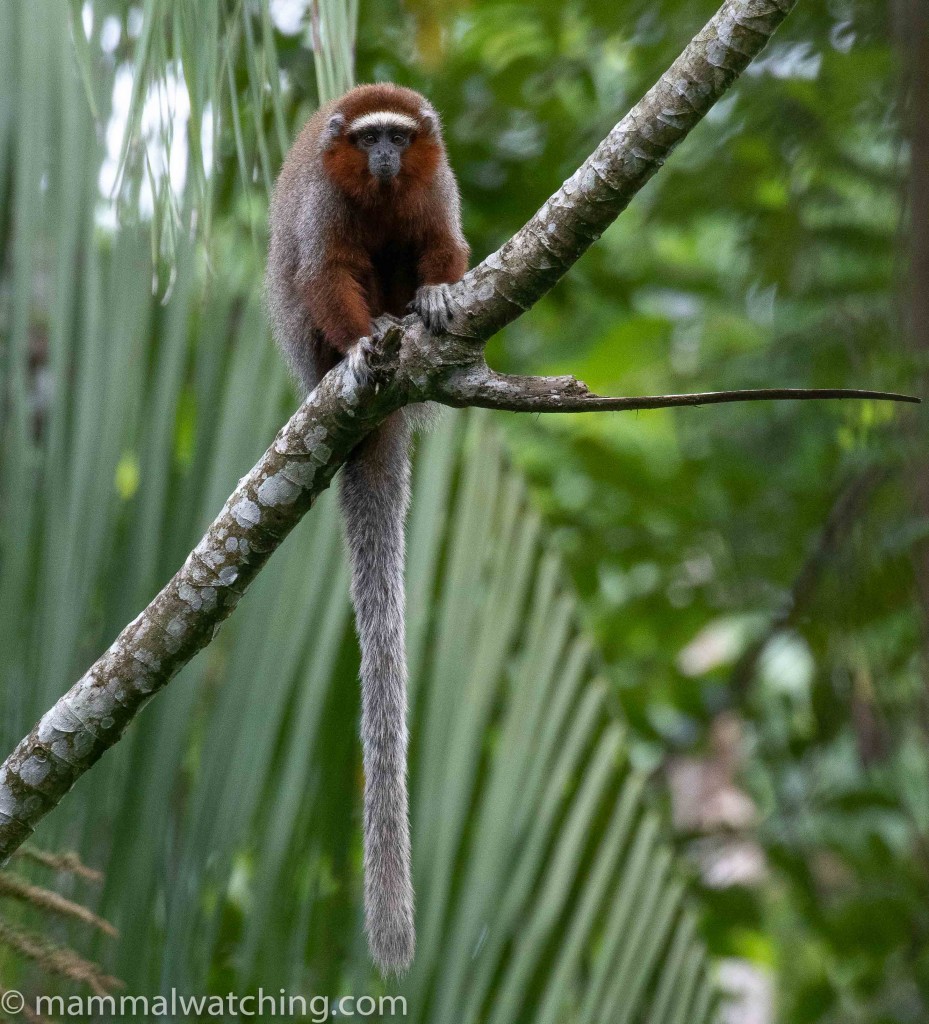
Ornate Titi, Callicebus ornatus
With Cheryl Antonucci, Becky Henshaw, Jon Hall, Martin Royle, Hari Sankar, Venkat Sankar and Ian Thompson. Plus Rob Smith and Claudia Diaz from Wild About Colombia.
When I first visited Colombia in 2006 it was love at first sight. It consistently features at number 2 in my answer to “what are your favourite countries?”. And that was before I had done much mammalwatching there. Back in the mid-2000s access to much of the country, especially the rural areas, remained difficult. But the peace process and crackdown on the cocaine cartels mean the country’s mammals are now crying out to be watched. And there are a LOT of mammals. There is a lot of everything. Colombia is often ranked as the second most biodiverse country on the planet, just behind Brazil, a country more than 7 times as large.
So, when Justin Brown sent me a trip report in January 2019 I was only half way through reading before I was emailing his guide – Robin Smith at Wild About Colombia – to set up a trip.
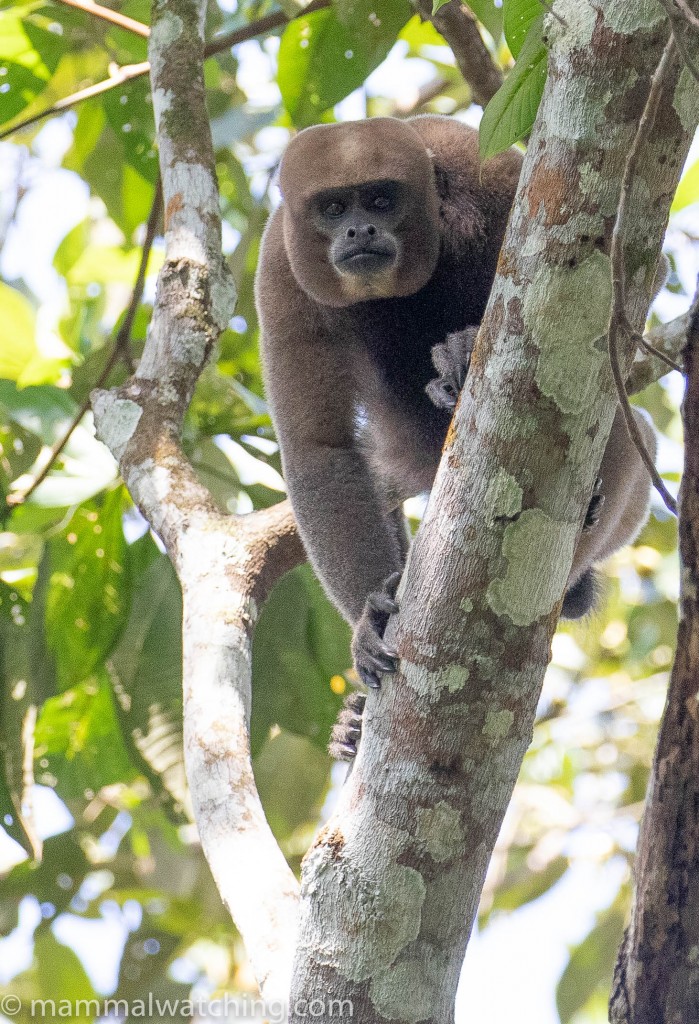
Common (Brown) Woolly Monkey, Lagothrix lagotricha
Rob reckoned with a bit of luck we ought to be able to find 10 endemic – or near endemic – primates in a week. I sent out some emails and a few days later 7 other mammalwatchers and I were looking forward to a January 2020 visit.
Wild About Colombia
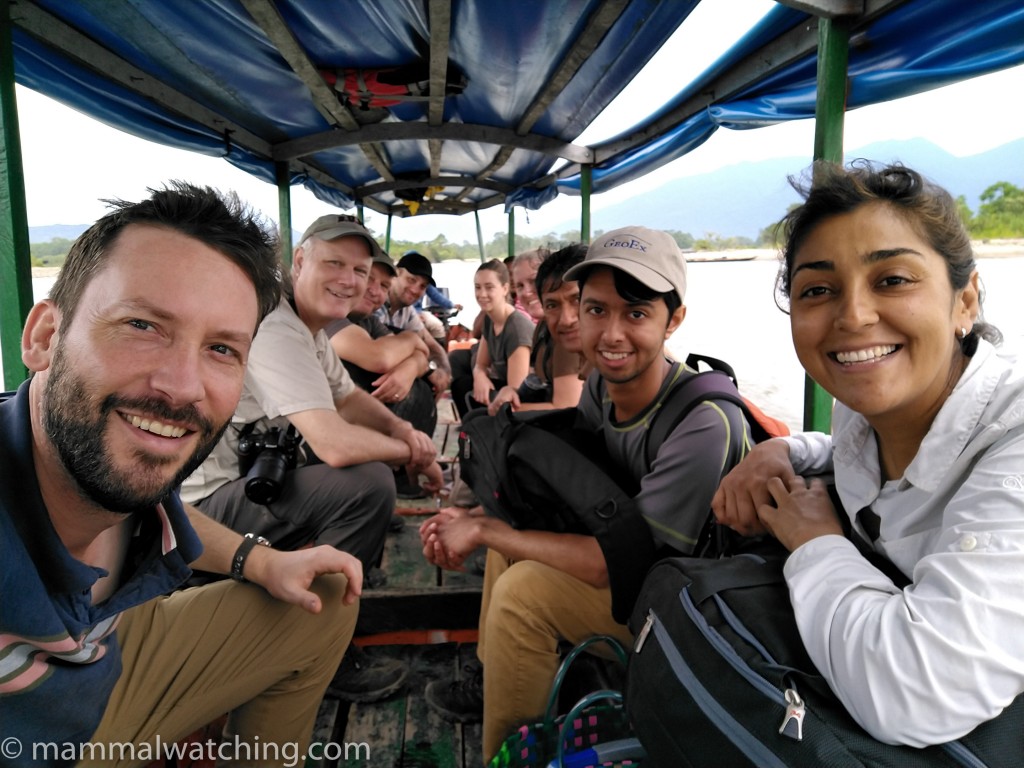
Rob, Claudia and the rest of us
Justin Brown had nothing but praise for the Wild About Colombia team. I will add to that now. Rob Smith and Claudia Díaz were superb in every aspect of the trip, from answering emails immediately through to spotting animals in the forest. I don’t think I’ve ever been on a tour where everything worked quite so smoothly and we nailed every single one of our targets.
Rob and Claudia made the logistical side of the trip seem effortless. In truth there was a lot of work going on behind the scenes, with Claudia calling or visiting ahead to confirm, and re confirm, every pickup and hotel, and ensure the famously erratic internal flight schedule hadn’t changed at the 11th hour.
A trip like this was unthinkable a few years ago and they have broken new ground with a ton of research to discover the go-to spots for many of our target species. Even if I was to include GPS locations, which I won’t, it would be pretty much impossible to visit many of these areas without the local contacts and guides that Wild About Colombia work with. And, before Rob and Claudia get any more embarrassed by the praise, I will finish by mentioning they are both committed to conservation and extremely good company both in the forest and over a beer. Or two. Or three.
Itinerary and key targets
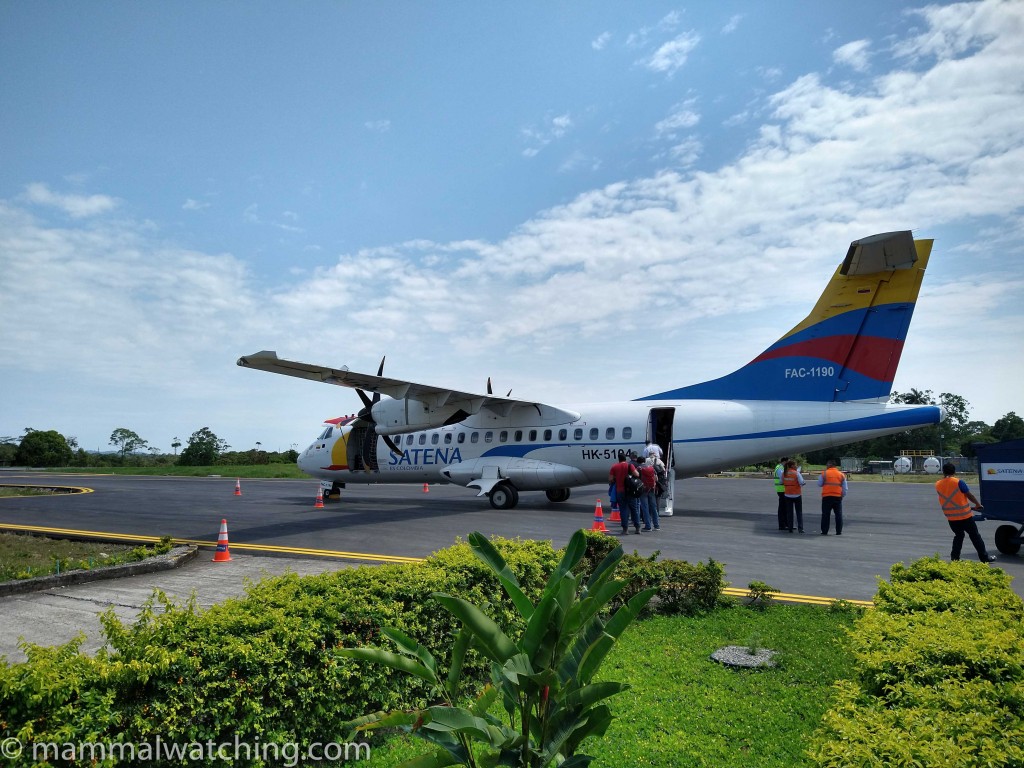
January 3 Arrive Bogota
January 4 Drive to Villavicencio for Ornate Titi and Brumback’s Night Monkey
January 5 return to Bogota and fly to Puerto Asis
January 6 Drive to Mocoa for Black-handed and Yellow-handed Titi
January 7 Colombian Woolly Monkey, Mocoa
January 8 drive and boat to Miraflor for Caquetá Titi
January 9 Fly to Bogota and then to Medellin
January 10 Drive through Magdalena Valley for Silvery-brown Bare-faced Tamarin and Varied Capuchin to El Paujil Reserve
January 11 Variegated Spider Monkey and Grey-handed Night Monkey, El Paujil Reserve
January 12 Return to Bogota
Post-tour Extension
January 13 Long drive to San José del Guaviare for Mottle-faced Tamarin and Black (Collared) Titi
January 14 Golden-backed Uakari, San José del Guaviare
January 15 Fly to Bogota and home
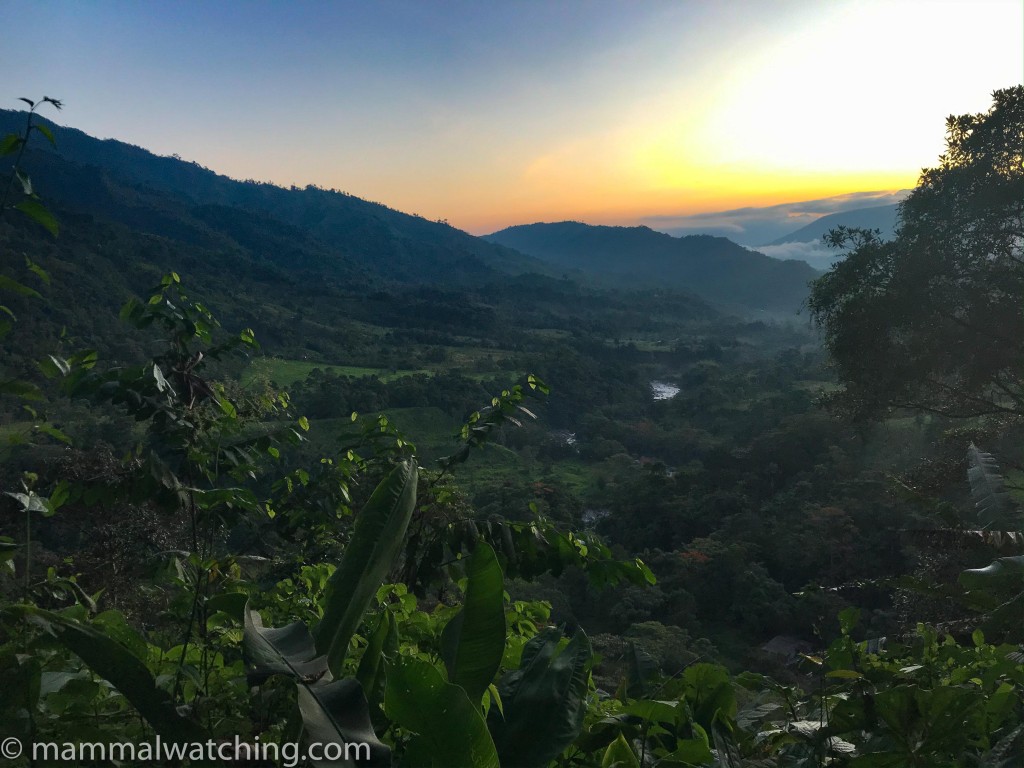
January 3. It is quicker to fly from New York to Bogota than New York to San Francisco. Why had I waited so long to return?
Rob was waiting for me as I cleared immigration and five minutes later I was checking into the Hilton airport hotel for a few hours’ sleep.
Meta Department
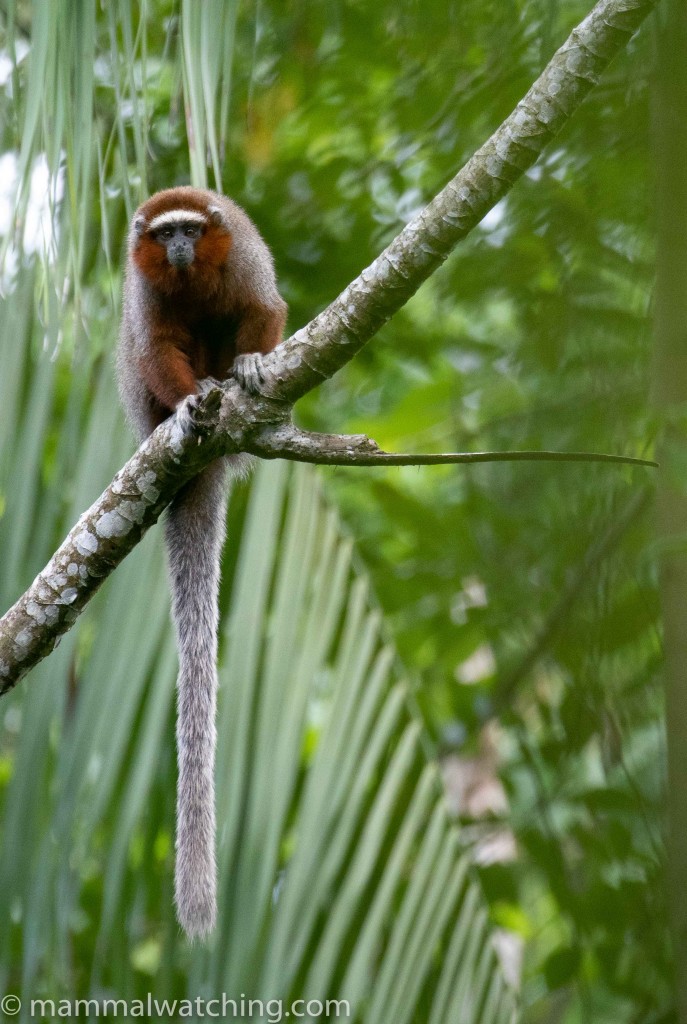
Ornate Titi, Callicebus ornatus
January 4. We were on the road by 7 a.m in a very comfortable minibus – reclining seats and a heap of space – for the drive south to Villavicencio which lies on the edge of the Colombian llanos – a vast area of seasonally flooded grassland that stretches into and across Venezuela. The drive ought to take 2 – 3 hours, but heavy holiday traffic meant it was close to midday by the time we arrived. Rob met our local guide Elvis, and Natalia, an Ornate Titi Monkey researcher, and we drove to a finca (small farm) close to Villavicencio.
Like several of the places we visited, the area was a patchwork of privately-owned agricultural land and remnant forest. The monkeys are clinging on in the forest and Natalia was working with local landowners to try to reverse land clearing and connect forest patches. From what I could gather many were quite receptive. Visits like ours, which generate some revenue for the farmers and – I imagine – some pride in the importance of their role in conservation, have to be a good thing.
Within 30 minutes Natalia had helped us to track down our first Ornate Titis. Beautiful things and not shy. Shortly after we saw the later split Colombian Squirrel Monkeys (Saimiri albigena).
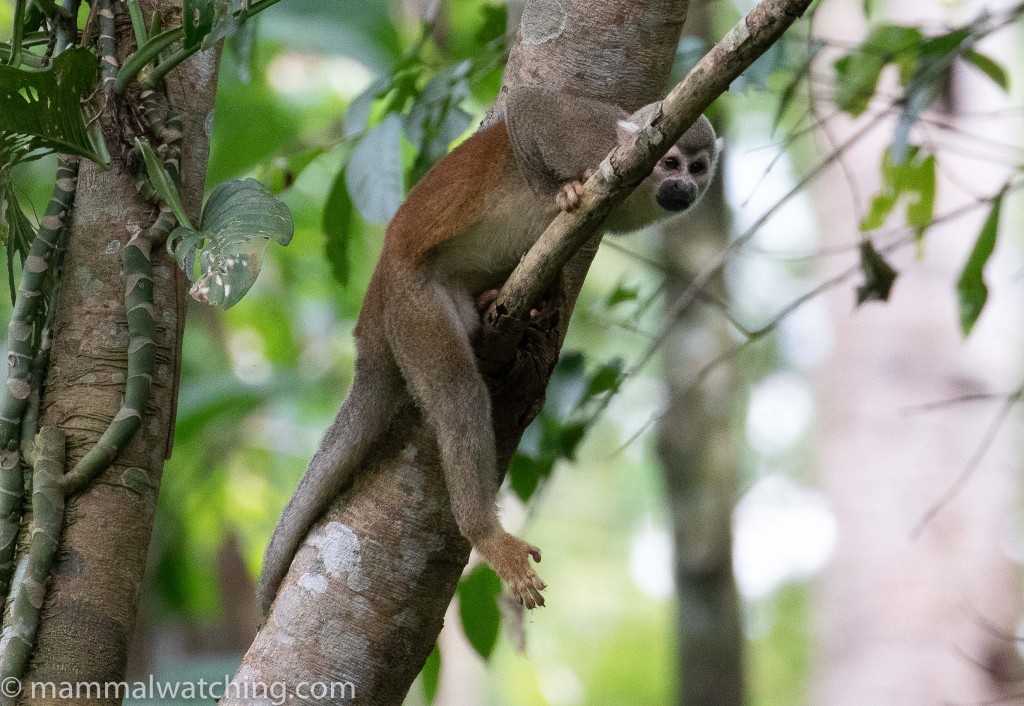
Colombian Squirrel Monkey, Saimiri albigena
And then Elvis spotted a sleeping Amazonian Long-tailed Porcupine.
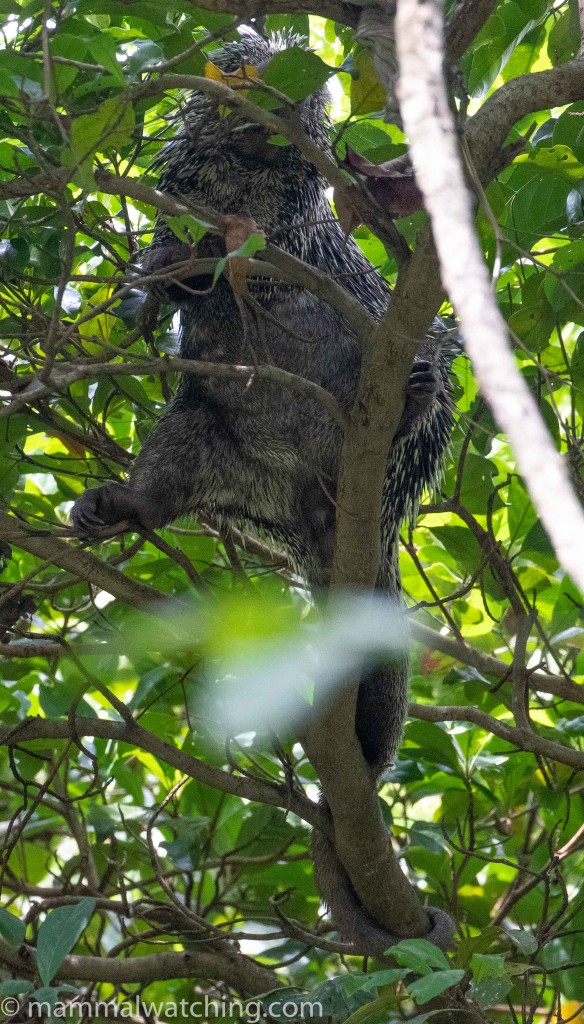
Amazonian Long-tailed Porcupine, Coendou longicaudatus
Lunch at the finca was delicious. After relaxing for a couple of hours we headed back out in the mid afternoon.
It did not take long to relocate the Ornate Titi Monkeys. They seemed very relaxed in their scrappy habitat with one using a barb wire fence to move from bush to bush.
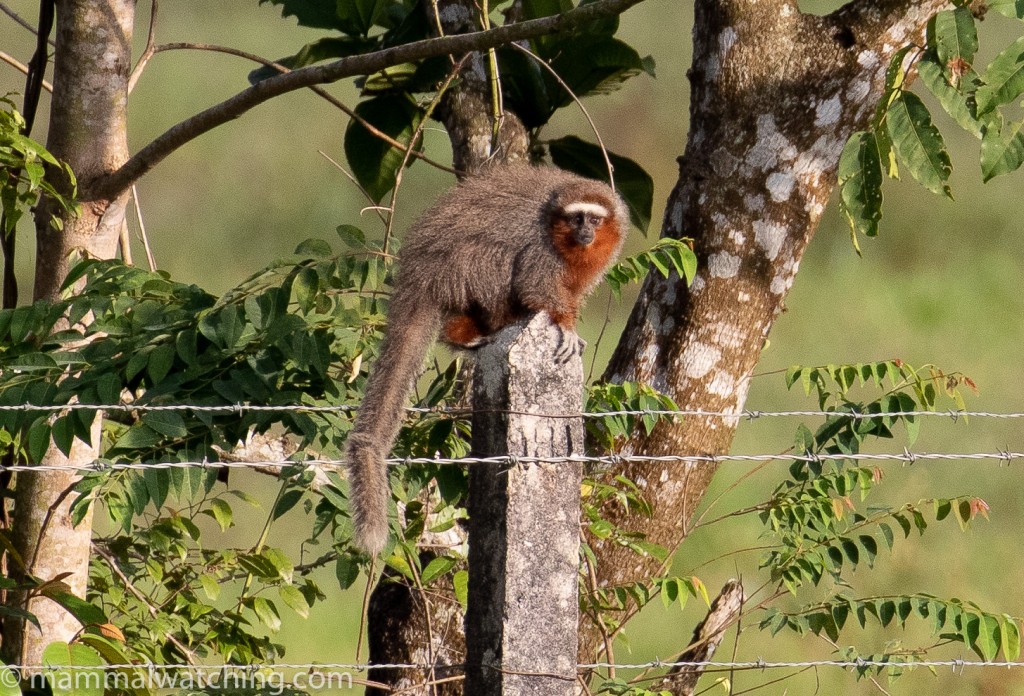
Ornate Titi, Callicebus ornatus
The area is also good for Giant Anteaters and we scoured the grasslands in the late afternoon for them.
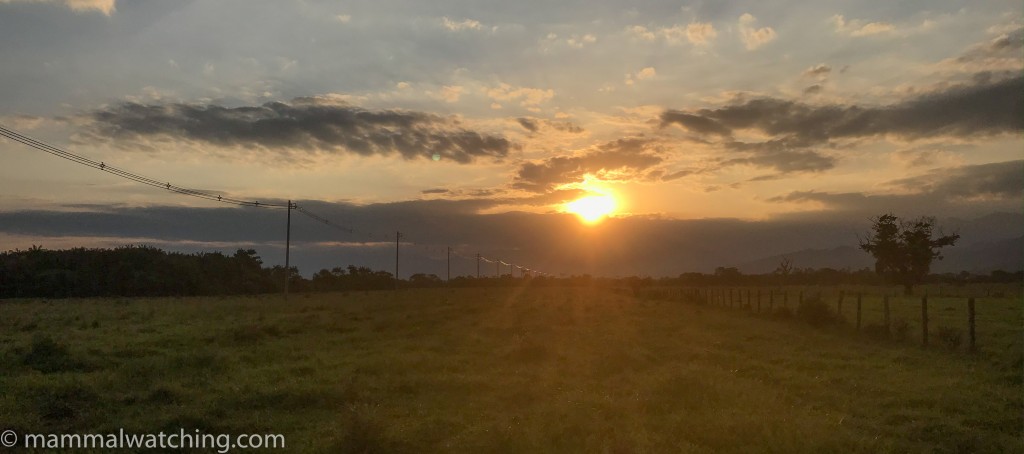
Giant Anteater habitat
Sure enough, around dusk, Natalia started waving in our direction and a fifteen minute jog later we had a long and superb look at a Giant Anteater. It has been almost 15 years since I have seen one and I am more convinced than ever that these are one of the planet’s 10 best mammals.
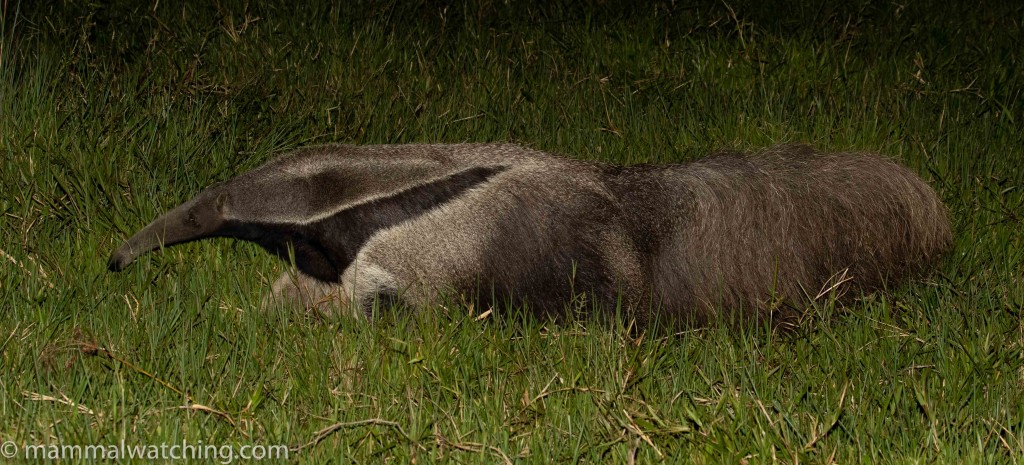
Giant Anteater, Myrmecophaga tridactyla
Back at the finca we took a short stroll along the edge of a forest patch and saw some pretty Brumback’s Night Monkeys, now split from Lemurine Night Monkey and endemic to the Colombian llanos.
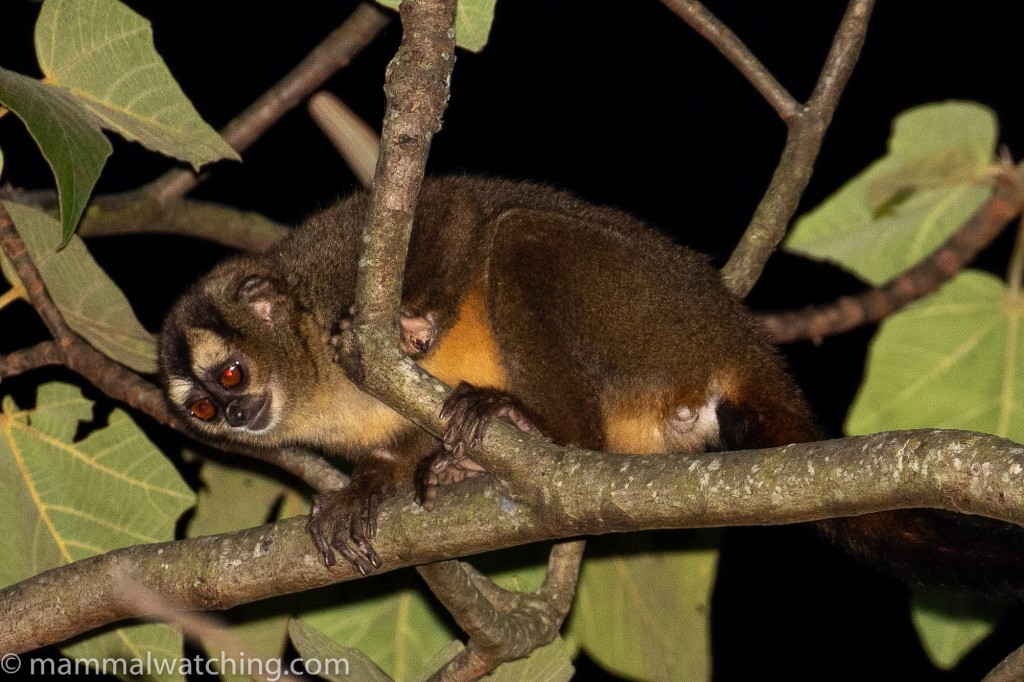
Brumback’s Night Monkey, Aotus brumbacki
It was gone 10 p.m. when we arrived at our eco-friendly guesthouse – Rancho Camaná – in bushland on the edge of town, but not too late for dinner and a welcome beer. Ian spotted a Common Opossum in the garden.
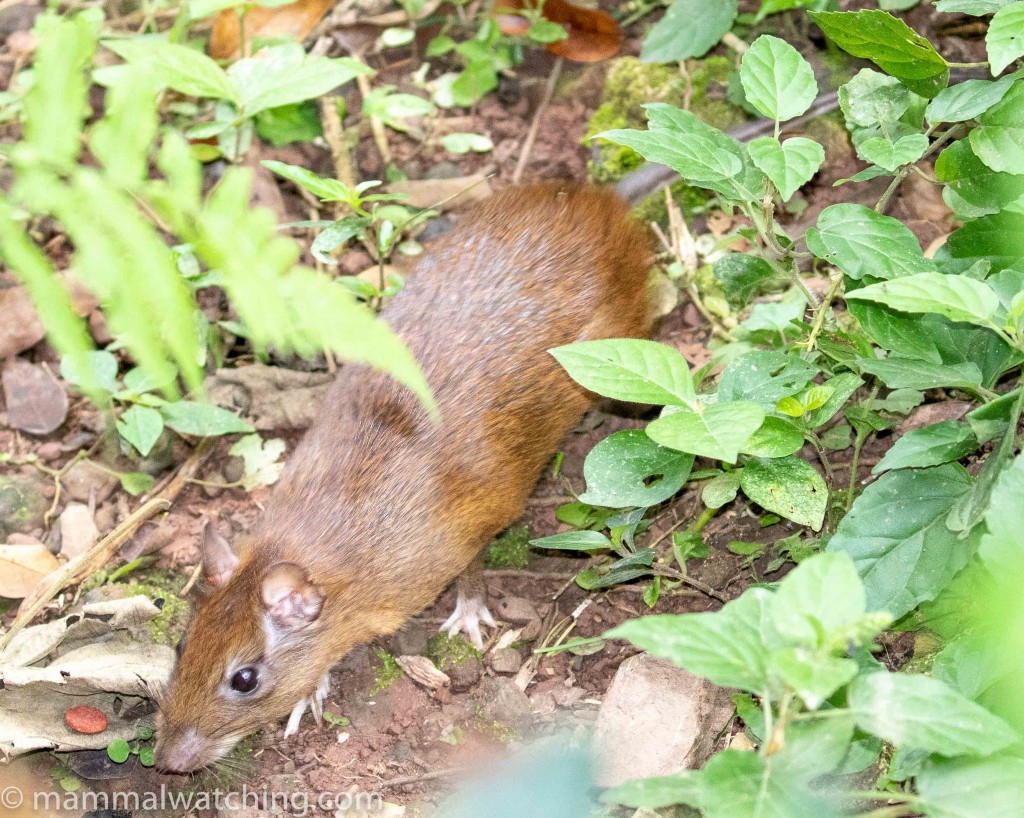
O’Connell’s Spiny Rat, Proechimys oconnelli
January 5. A flurry of rodent activity on the way to breakfast got the day off to a good start. This proechimys and her youngster were living in the flower bed outside the dining room and posed well for photos. The only proechimys in range appears to be O’Connell’s Spiny Rat.
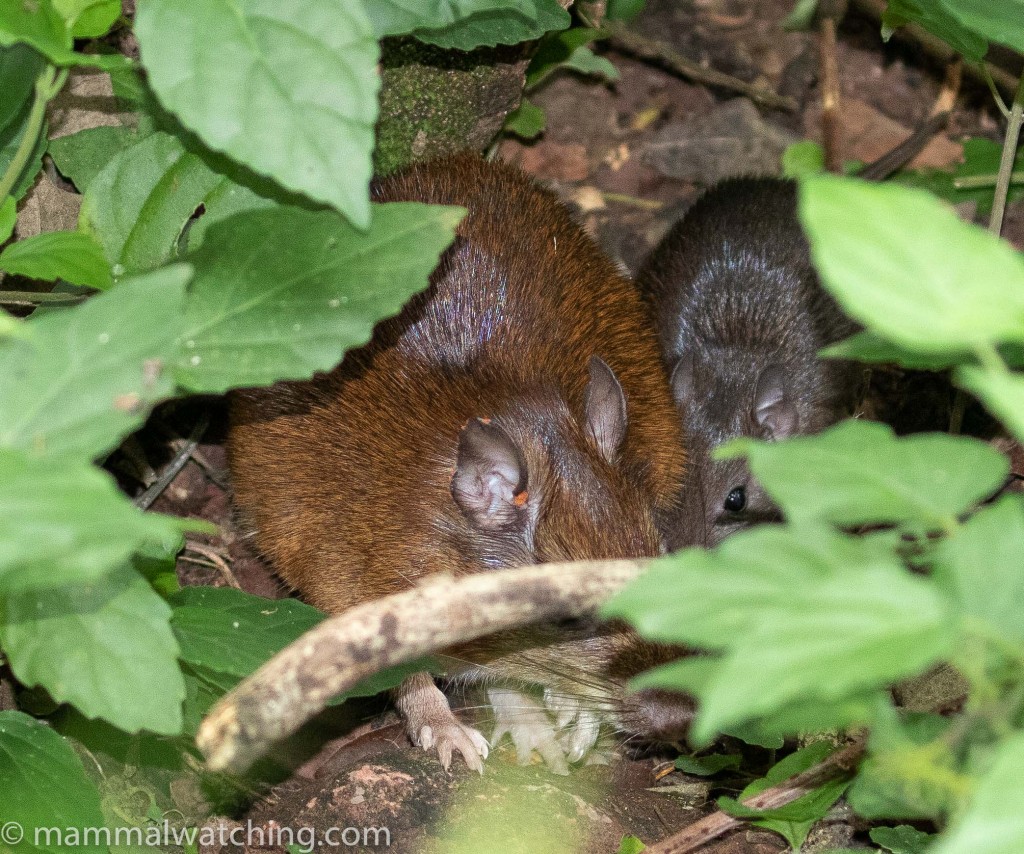
O’Connell’s Spiny Rat, Proechimys oconnelli
Ian saw a smaller, stocky, grey rodent that was more mouse than rat-sized. Unfortunately we could not relocate it.
Before driving back to Bogota we stopped at a Brumback’s Night Monkey roost tree, right on the edge of a road. The family group seemed as interested in us as we were in them.
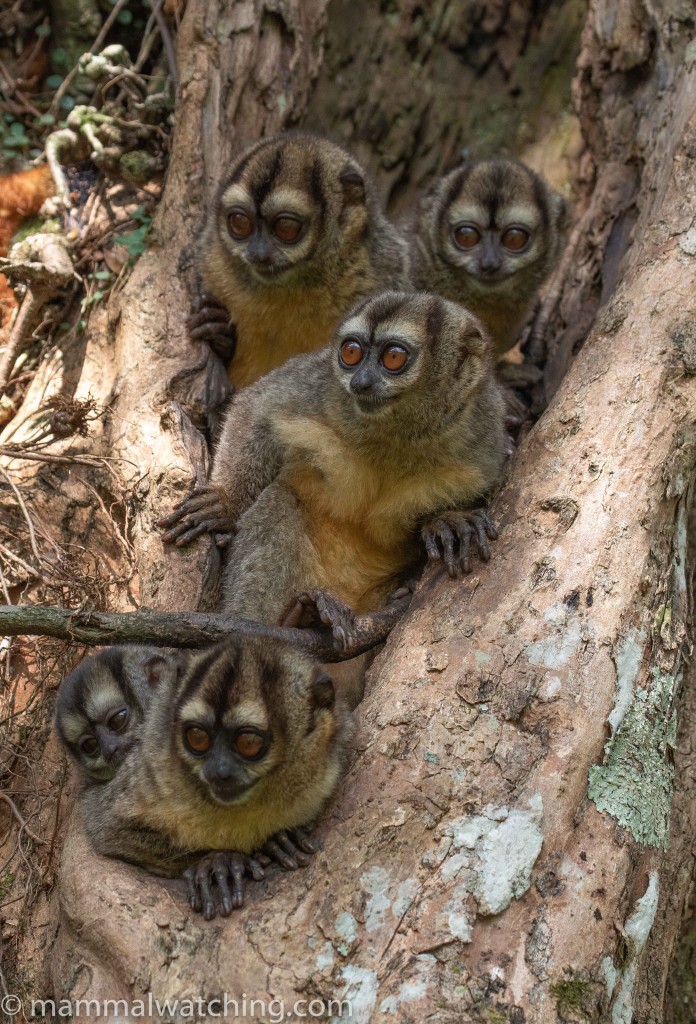
Brumback’s Night Monkeys, Aotus brumbacki
And then it was back to Bogota, with a stop for bad coffee and great arepas en route. A late afternoon flight on SATENA Air carried us south to Puerto Asis where we would spend the night. We met Rob’s partner Claudia at the airport, who would join us for the next leg of the tour ,primarily to triple check all the arrangements as we moved around.
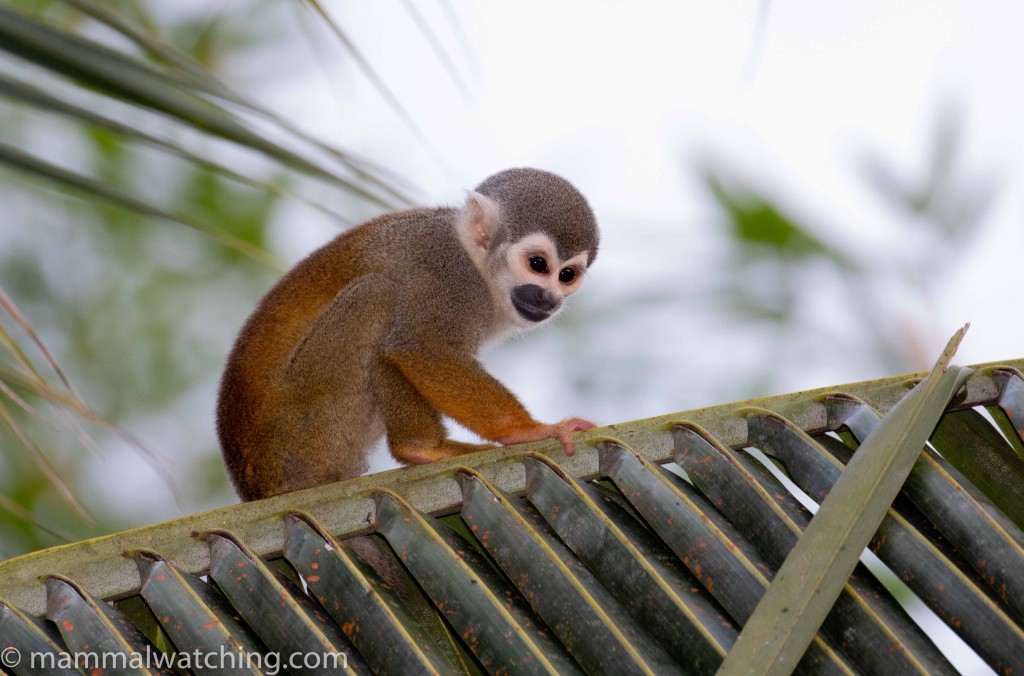
Ecuadorean Squirrel Monkey, Saimiri macrodon
The area is not super safe still after dark, so our local guide, Edilson, whisked us straight to a local nature reserve to show us a roost of Spix’s (Noisy) Night Monkeys before it got dark. They were not at all noisy. And a troop of Ecuadorean Squirrel Monkeys were up to mischief in the car park (this species – Saimiri macrodon is a recent split, ands different to those we had been looking at in Villavicencio).
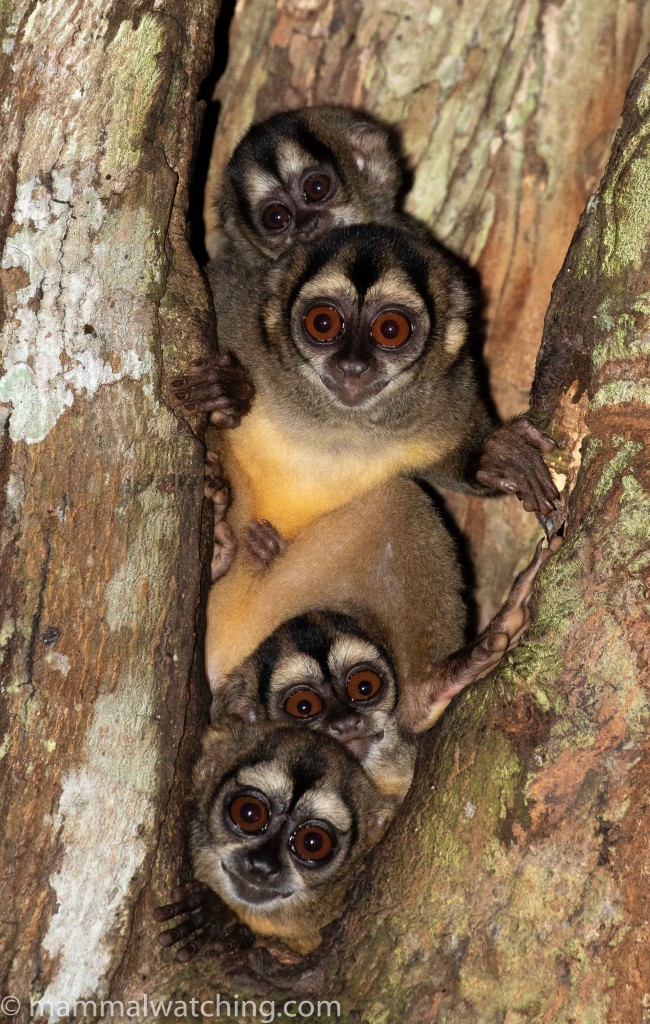
Spix’s (Noisy) Night Monkey, Aotus vociferans
In Puerto Asis we realized the biggest risk to our safety was being pinged by a small bag of flour. The town was celebrating its annual Black and White festival. This is supposed to be about multiculturalism. It is also about giving people an excuse to throw things at each other. Yesterday it had been black ink. Today it was white flour, which covered the roads and sidewalk so completely the place looked like Siberia.
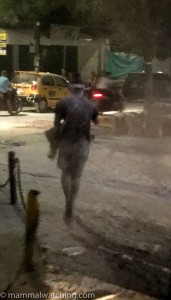
Flour power in Puerto Asis
Flour-carrying hitmen zipped around town on mopeds and I was caught when I braved the five second dash from bus to hotel.
Putumayo Department
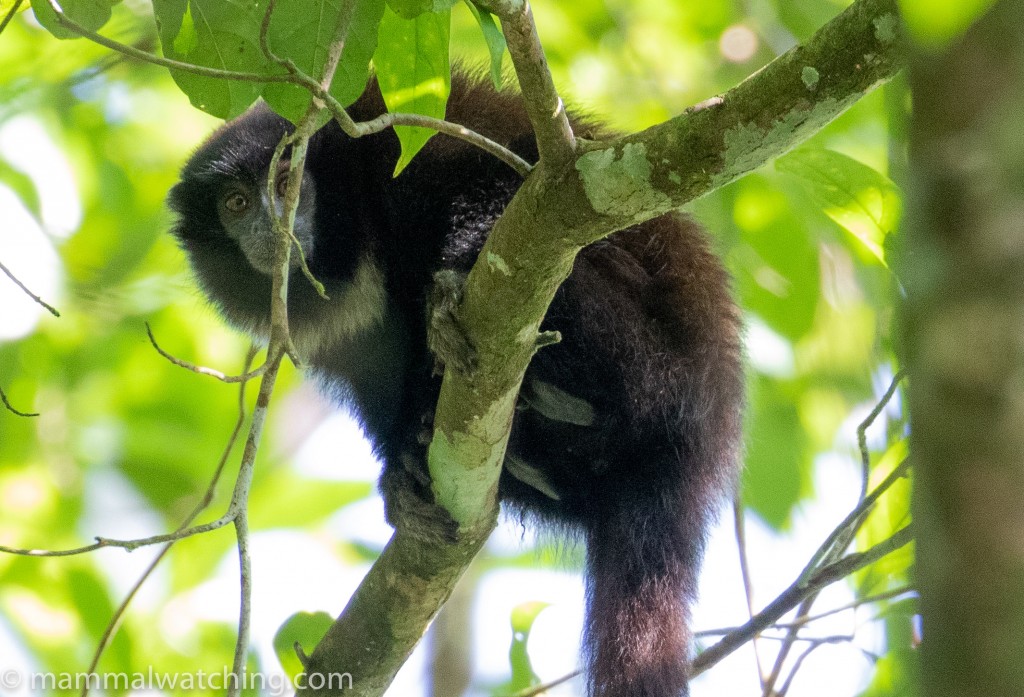
Lucifer and Medem’s Titi Hybrid, Callicebus sp.
January 6. We left very early in another comfortable minibus to a small private reserve near the town of Mocoa where we had two key targets: Black-handed and Yellow-handed Titis. It’s a 20 minute walk into the reserve and within five minutes we spotted the first titi monkeys.
The two species look very similar unless you can see their hands. Even then it wasn’t always clear. The animals below, for example, are classic Black-handed (Medem’s) Titi Monkeys.
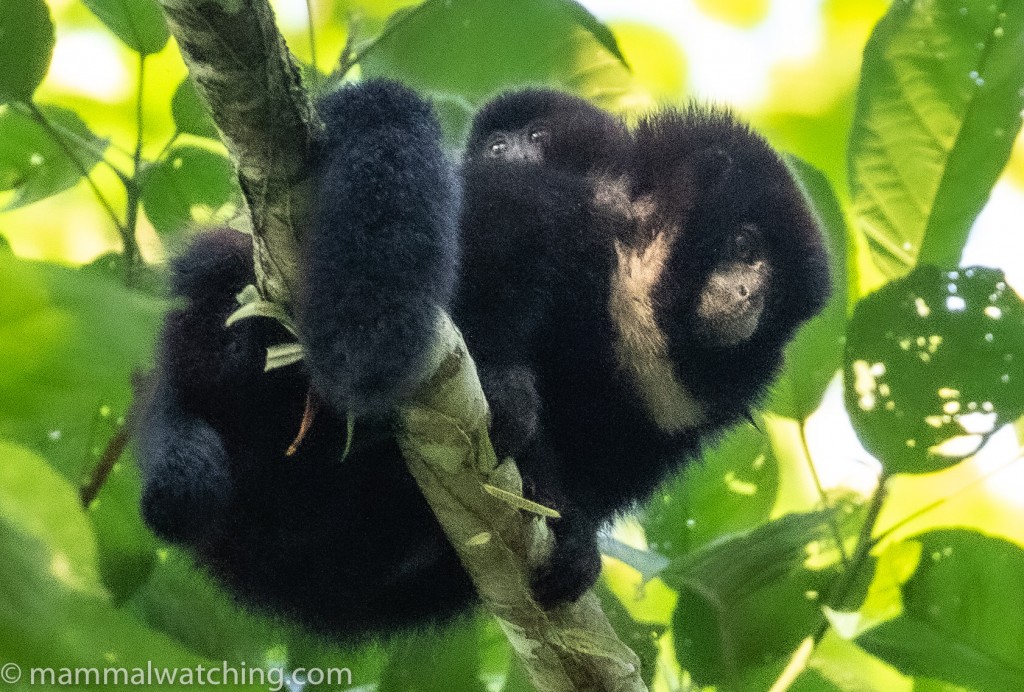
Medem’s (Black-handed) Titi, Callicebus medemi
Whereas this one had obvious yellow hands: a Lucifer Titi.
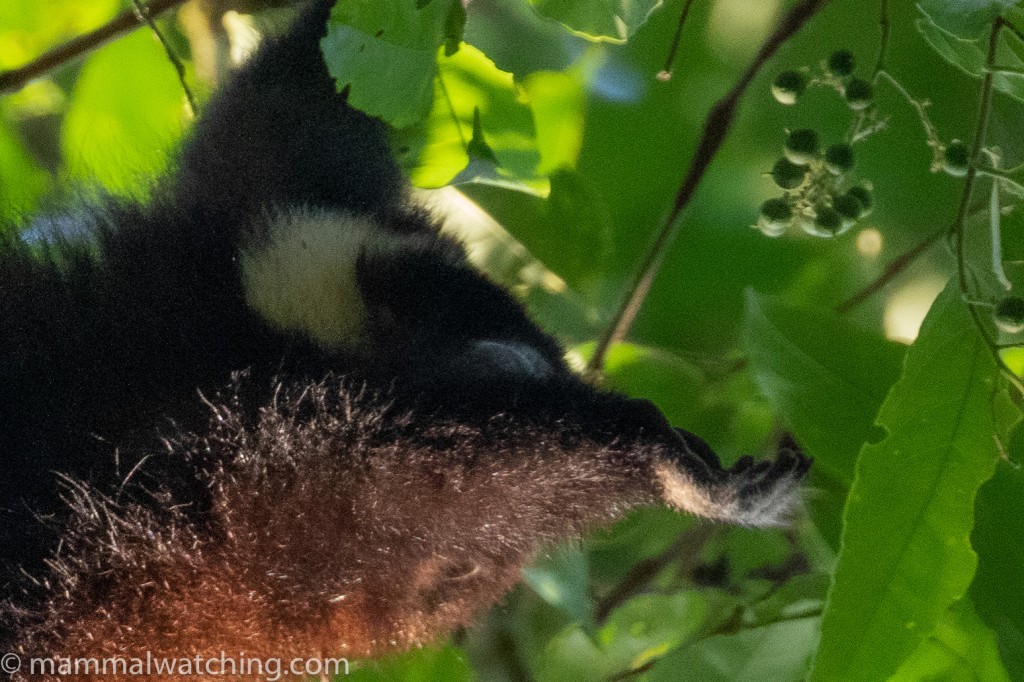
Lucifer (Yellow-handed ) Titi, Callicebus lucifer
But several others had greyish hands and we guess were most likely hybrids which would make a lot of sense given that not only do the two species live side by side, but they appear to interbreed: we saw at least one family group that had a mixed pair of adult titis.
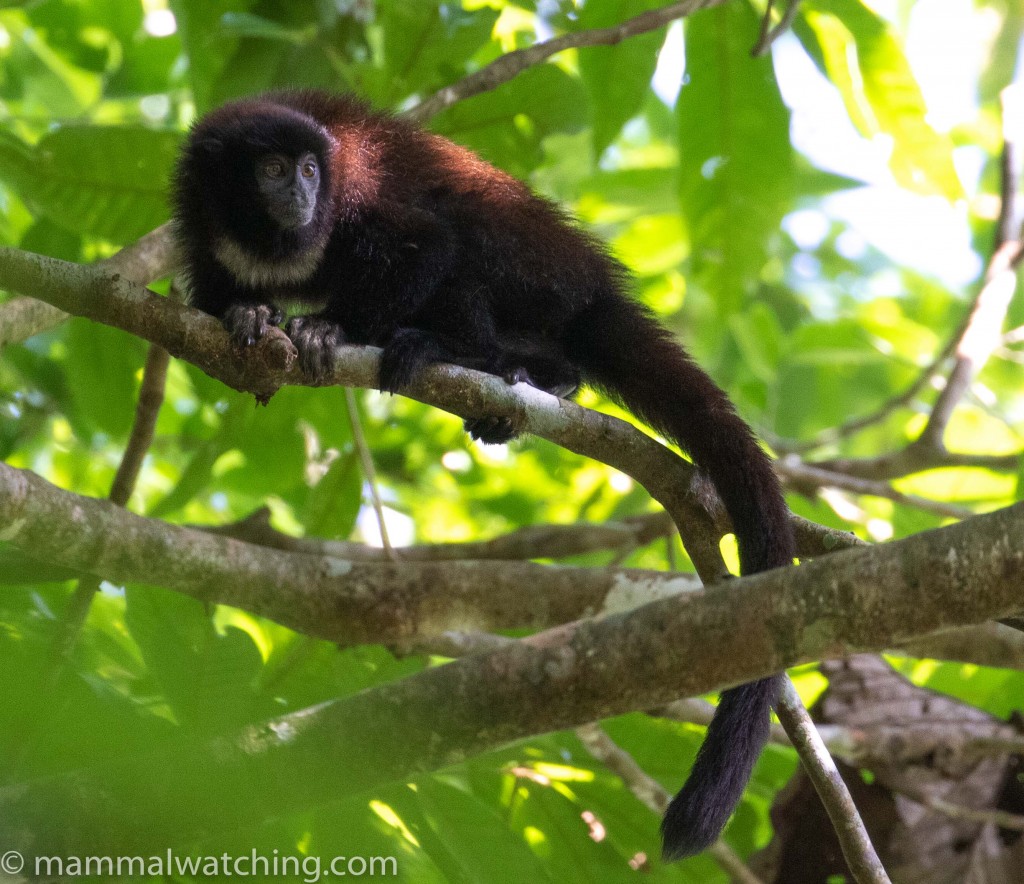
grayish-handed – mudblood? – Titi, Callicebus sp
I am not sure whether much genetic work has been done on these animals. And whether both species, which were split from Collared Titi, stand the test of time remains to be seen. But I’m counting them both for now as does the IUCN. A tick is a tick!
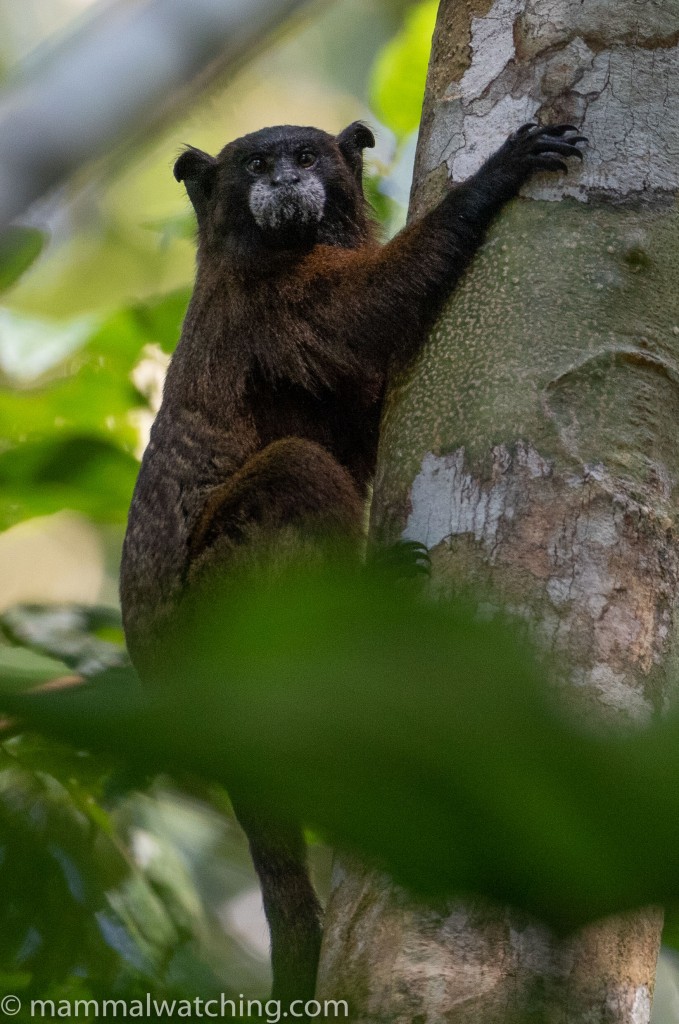
Lesson’s Saddle-backed Tamarin, Leontocebus fuscus
Later that morning we had a long encounter with Lesson’s Saddle-back Tamarins, a recent split and a lifer for all of us, along with a few Common Squirrel Monkeys.
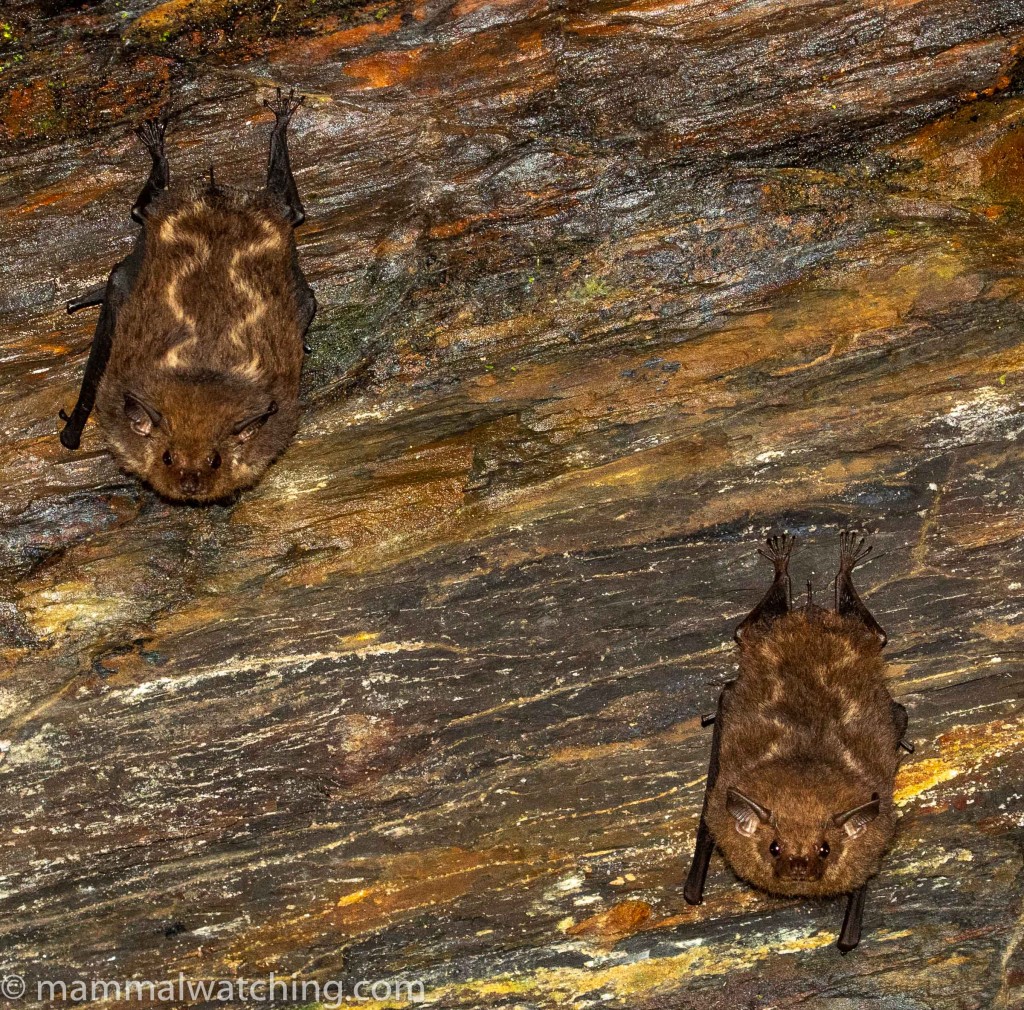
Lesser White-lined Bat, Saccopteryx leptura
Edilson showed us a few Lesser White-lined Bats on a rocky overhang as well as a Brown-throated Three-toed Sloth along the trail.
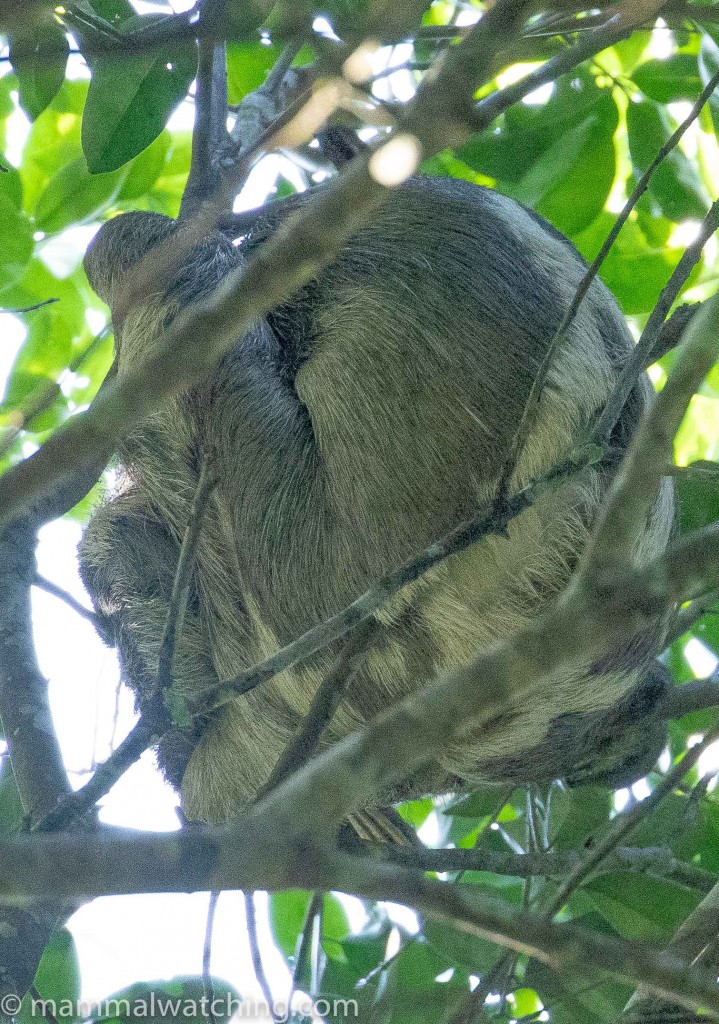
Brown-throated Three-toed Slot, Bradypus variegatus
After another good lunch plus optional siesta,.some decided to make the most of our beautiful rooms at Posada Turistico Dantayaco that evening in Mocoa. Every restaurant in town was closed and so Claudia bought groceries and prepared dinner in the hotel kitchen.
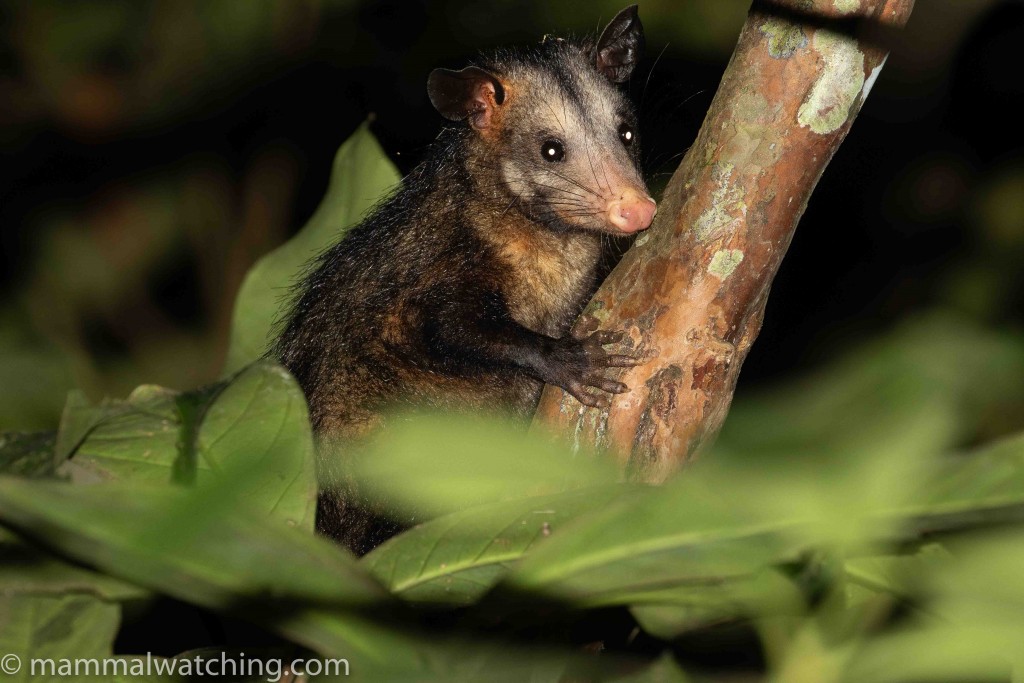
Common (Southern) Opossum, Didelphis marsupialis
The rest of us spent an evening at a finca in some partially flooded forest looking for Silky Anteaters which Edilson had seen here a few times non the past. We couldn’t find the Silky Anteaters but did see some Silky Short-tailed Bats in a tree and a Common Opossum.
January 7. Until now Rob had been quietly confident about each day’s target species. But today was different. We had a long – 20km – walk ahead of us through cloud forest in search of Colombian Woolly Monkeys, another endemic and critically endangered subspecies (though this was considered a distinct species recent work – as of 2020 – has lumped most of the woolly monkeys together). This was an animal that was going to be considerably harder to find than the monkeys we had seen so far.
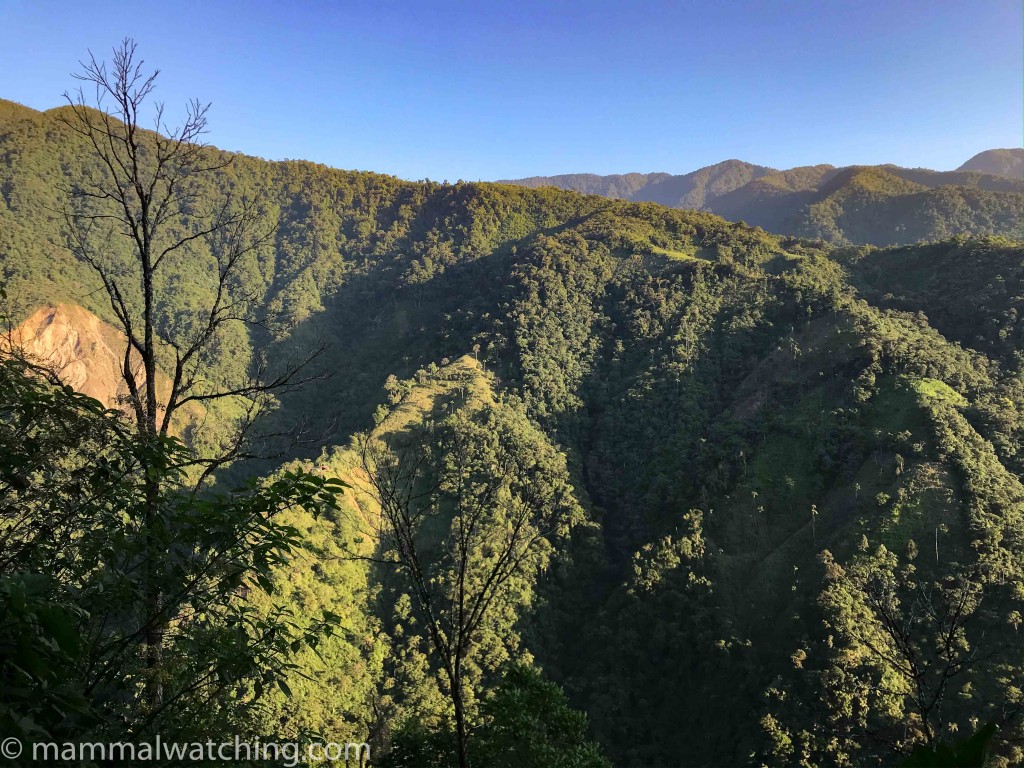
Colombian Woolly Monkey habitat
An early start, surprise surprise, had us on the trail head at sunrise and some of us saw a Black Agouti scamper across the path in the first few minutes.
We had three hours walking up a gentle slope ahead of us to get into the best Woolly Monkey habitat. The trail was good and the walk was much easier than I had expected. Woolly Monkeys are occasionally seen lower down the trail. Edilson, whose family own a house in the area, had seen them just an hour up the trail a few weeks earlier and sure enough we heard one calling less than two hours into our walk. But we couldn’t spot it. We saw some Brown Capuchins nearby.
Once we got into better habitat the trail got a little more rugged and we walked for another two hours without even a hint of Woolly Monkey. We stopped for lunch. I was beginning to feel despondent and began psyching myself up for the long, hot, monkeyless, walk back to the minibus.
But it is always darkest before the dawn. As we were packing up to leave some noise directly above our lunch spot turned into a monkey which turned into a Colombian Woolly Monkey! We had a short but good view of an animal crossing the trail in the canopy above us and Venkat was quick enough to grab a record shot.
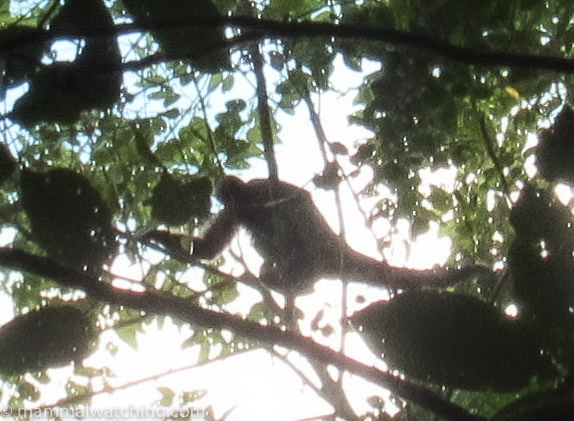
Colombian Woolly Monkey, Lagothrix lagotricha lugens. Photo Venkat Sankar.
Elated we bounced back along 13kms of trail to the minibus.The 25km walk that day meant everyone was happy not to go spotlighting that night. We arrived at the hotel just before sunset and just in time to see one of the habituated Pygmy Marmosets that visit the hotel each late afternoon. An animal turned up to grab a banana from behind the kitchen right on dusk. The previous afternoon they had been running around people’s balconies.
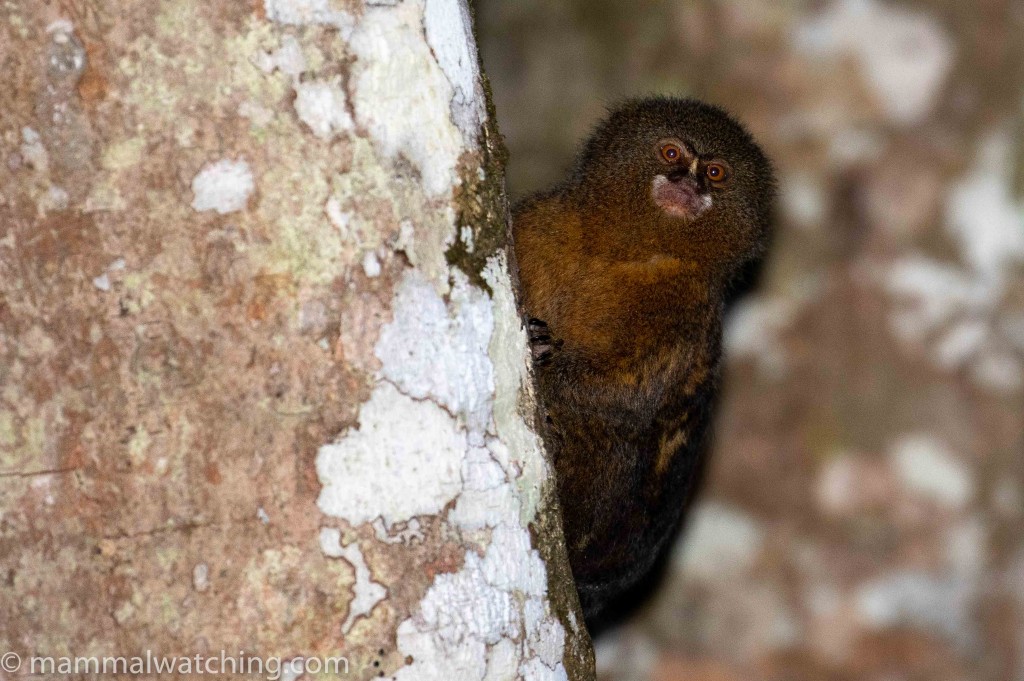
Pygmy Marmoset, Cebuella pygmaea
January 8. Before dawn we were on the road to Miraflor stopping only to look at an injured Crab-eating Raccoon that had just been hit by a car.
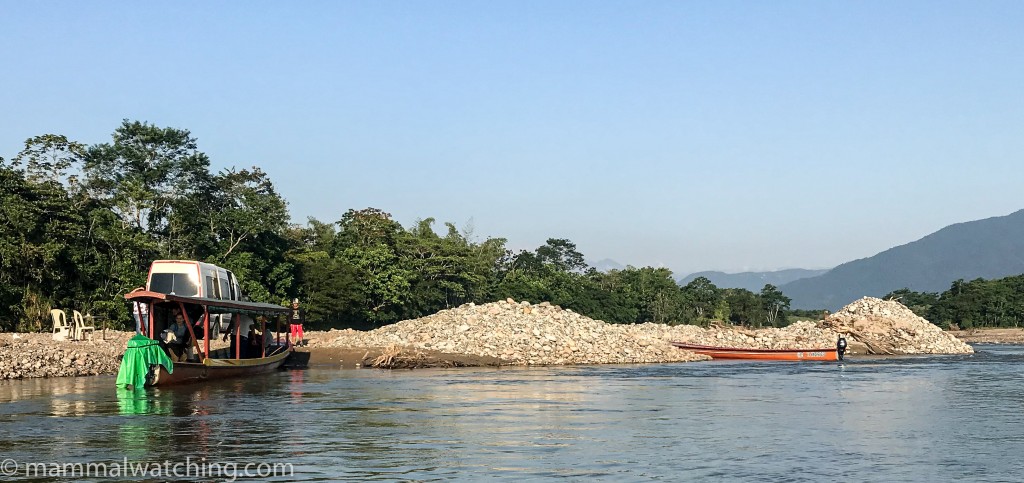
The Miraflor Ferry Terminal …
A motorboat ferried us the 10 minutes across the river to a couple of pick-up trucks waiting to take us to Miraflor. We were well and truly off the grid here, in an area that very few tourists visit. Driving along a dirt road, with a local tune on the radio, was a scene straight out of Narcos, the brilliant Netflix show about the war against Pablo Escobar.
Today’s target was the critically endangered Caquetá Titi. Rob had tracked down a small finca where a few of the monkeys survived and Alexis, our local guide from the farm, was waiting for us on the roadside. Alexis had heard two groups of Titis calling that morning, and we were able to see a family not far from his house. But they were rather shy and hard to photograph.
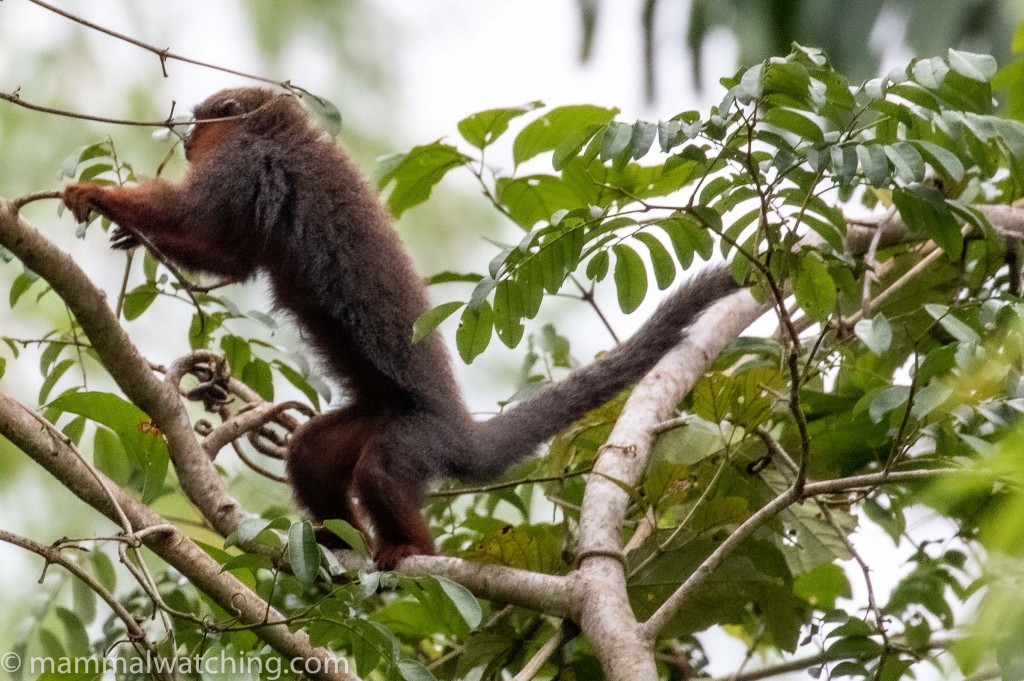
Caqueta Titi, Callicebus caquetensis
After lunch at the finca we spent the later half of the afternoon looking for the monkeys though only. Rob saw one. Alexis showed us a few Greater White-lined Bats roosting in the buttress roots of a massive tree and we got a brief look at a troop of Lesson’s Saddle-back Tamarins.
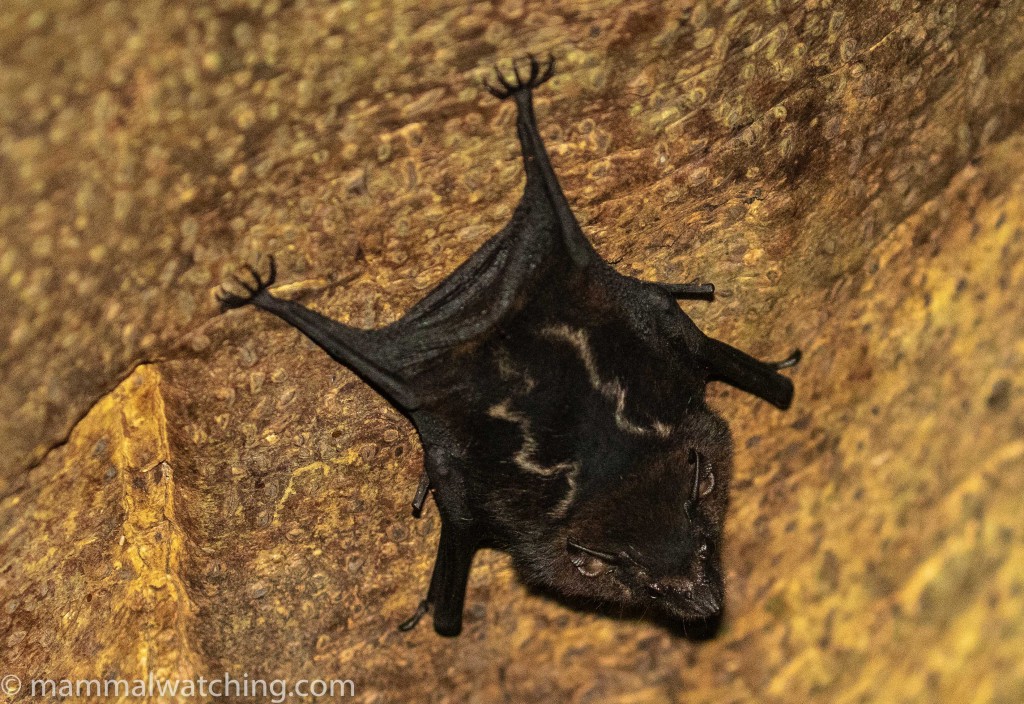
Greater White-lined Bat, Saccopteryx bilineata
We stayed in the tiny town’s only hotel and ate in somebody’s house There are no restaurants here.
January 9. We spent a couple of hours around the farm at dawn, hearing and then seeing the titis, though again they were rather shy. And then it was time to drive to the ‘ferry’ and to Villa Garzón for the flight back to Bogota. We said goodbye to Claudia, before connecting on to Medellin and the last leg of the tour.
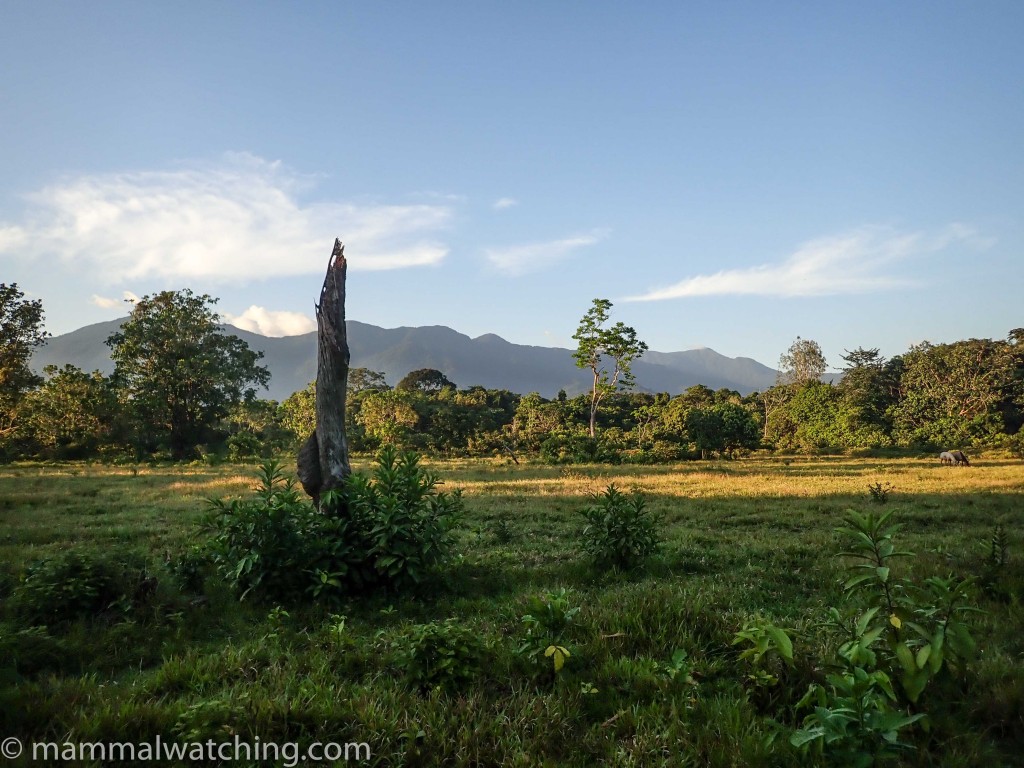
Caqueta Titi habitat
Dinner was a much-anticipated Italian meal in the hotel restaurant, the highlight of which was sharing the dining room with the Medellin football team who were celebrating the start of the season and initiating new signings by making them stand on a chair and sing. Hopefully they are better soccer players than entertainers.
The Magdalena Valley
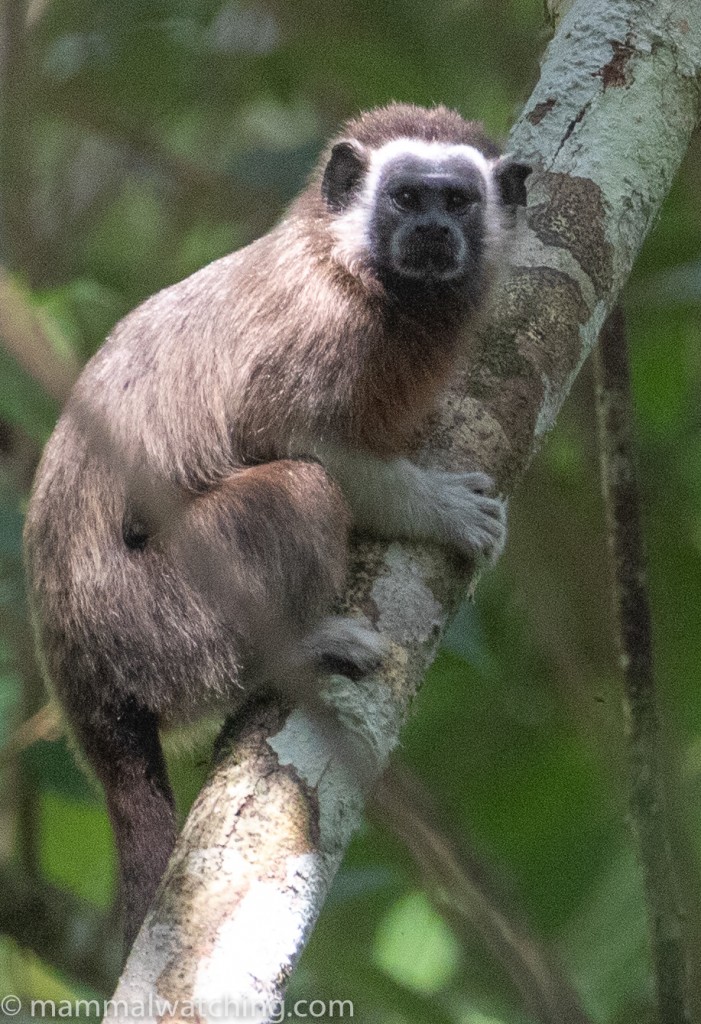
Silvery-brown Bare-faced Tamarin, Saguinus leucopus
January 10. The next two days were spent exploring the Magdalena Valley, east of Medellin. Though the valley is another hotbed of endemism, it has suffered massive deforestation, losing 98% of its forest area. Thankfully the 2% that is left is still worth seeing.
We pulled into the Rio Claro Nature Reserve, a popular spot with Colombian tourists,. The reserve hadn’t officially opened for the day and we walked the road looking for Silvery-brown Bare-faced Tamarins. No tamarins, but we got a good look at our first Varied White-fronted Capuchins, another Magdalena Valley endemic.
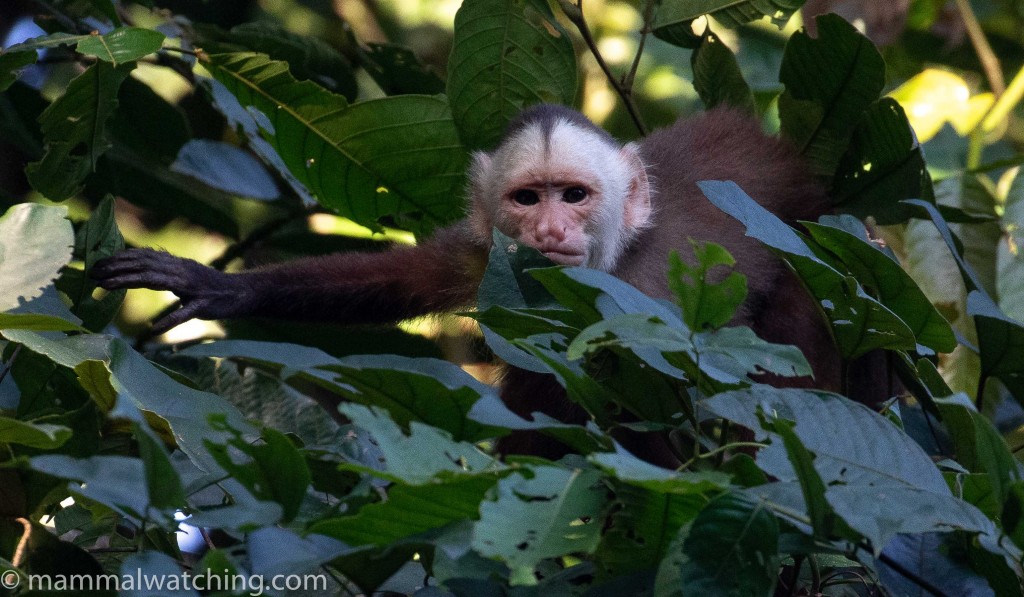
Varied Capuchin, Cebus versicolor
Meanwhile, back at the café, a Red-tailed Squirrel ran up Rob’s leg when he stopped in to get the latest monkey intel. So if you want to see that species, look no further.
Undaunted we drove a mile and walked a small truck infested road where Rob had had luck with the tamarins before. It took all of ten minutes to find a troop moving through the scrubby forest. Really strange looking things and one of the highlights of the trip for many.
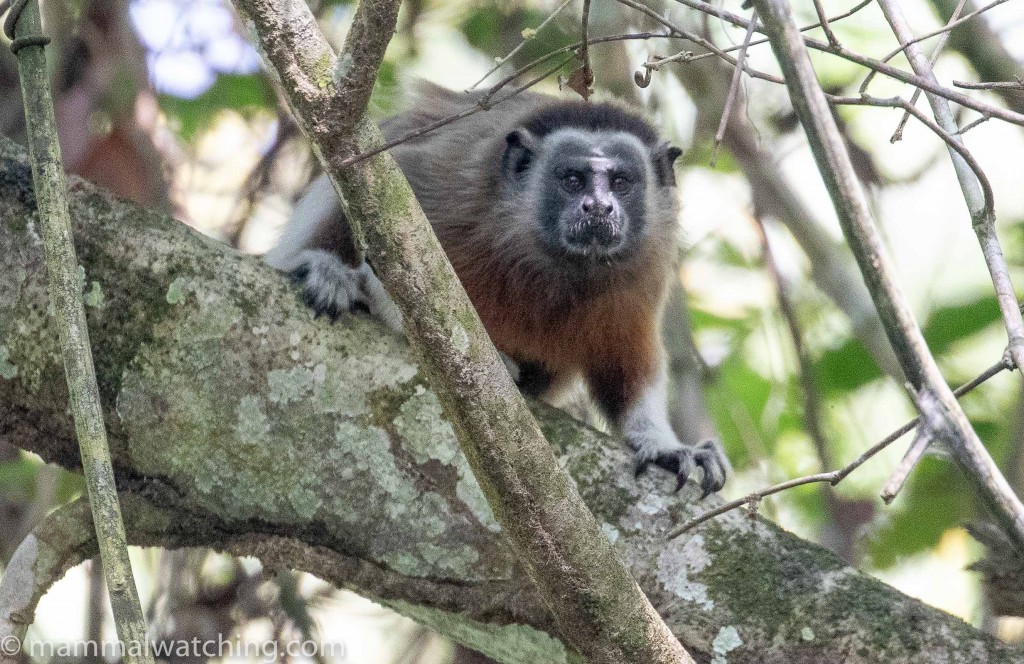
Silvery-brown Bare-faced Tamarin, Saguinus leucopus
After driving past Hacienda Napoles, the huge ranch owned by Pablo Escobar, and scanning the Magdalena River for the hippos that escaped from his zoo, we stopped for lunch.
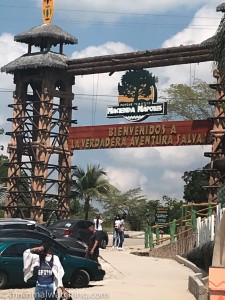
We traded our luxury minibus for an open-sided, Chiva, bus that could better deal with the road to El Paujil Reserve. These traditional buses are built for reliability rather than comfort and I was delighted to get out two hours later and walk into the reserve.
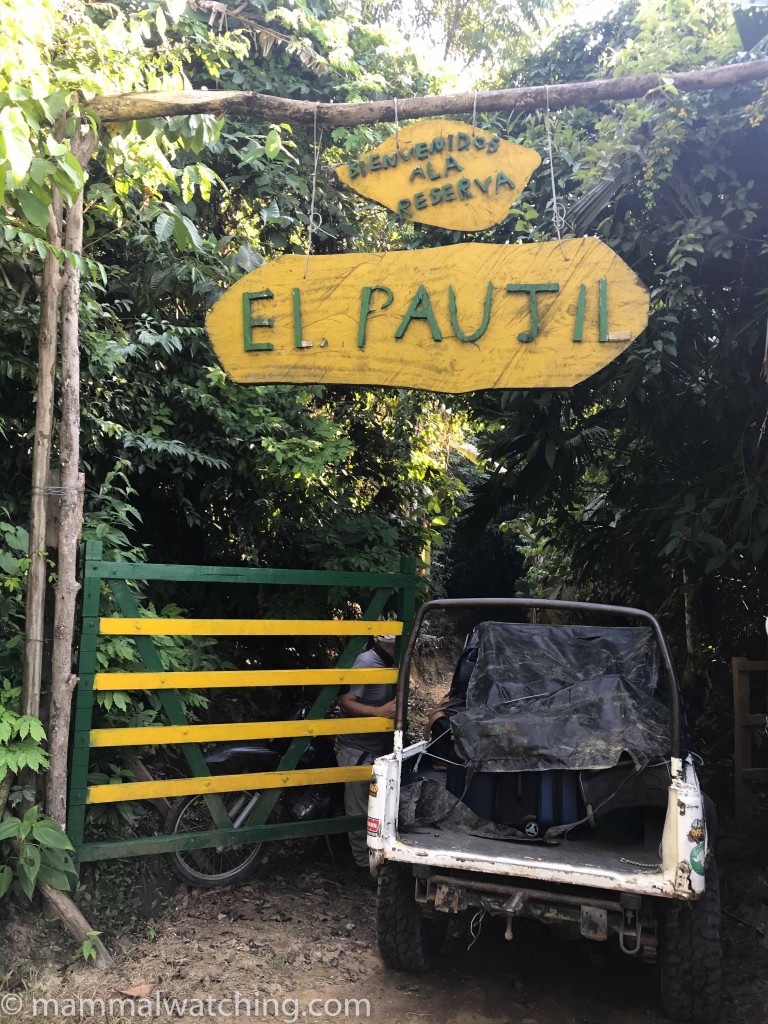
El Paujil is pretty much the last lowland rainforest in the Magdalena Valley. It was brought by ProAves, a Colombian bird conservation NGO, to protect the Blue-billed Curassows that live there.
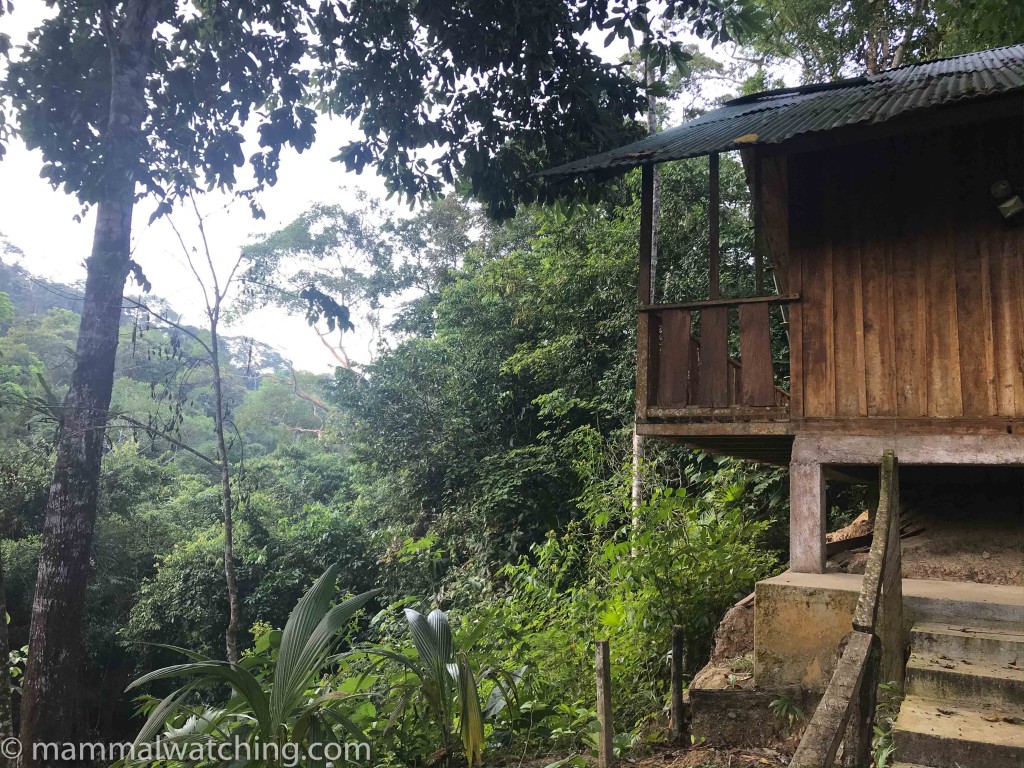
Rob had not exaggerated when he said the curassows were easy to spot. There were several sitting on the lawn by the restaurant when as we arrived, and they stayed there throughout our stay.
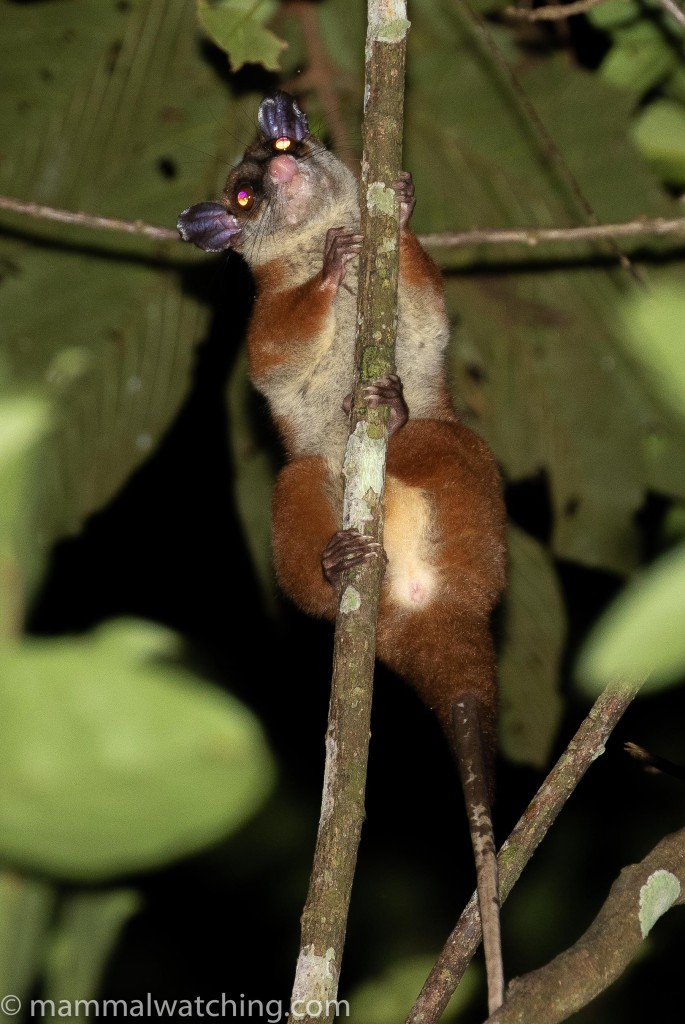
Western (Brown-eared) Woolly Opossum, Caluromys lanatus
Variegated (Brown) Spider Monkeys were our main target here along with Grey-handed Night Monkeys. But the reserve also offered the most promising spotlighting opportunities of the trip. We headed out after dinner for a few hours after photographing a Western (Brown-eared) Woolly Opossum next to the dining room.
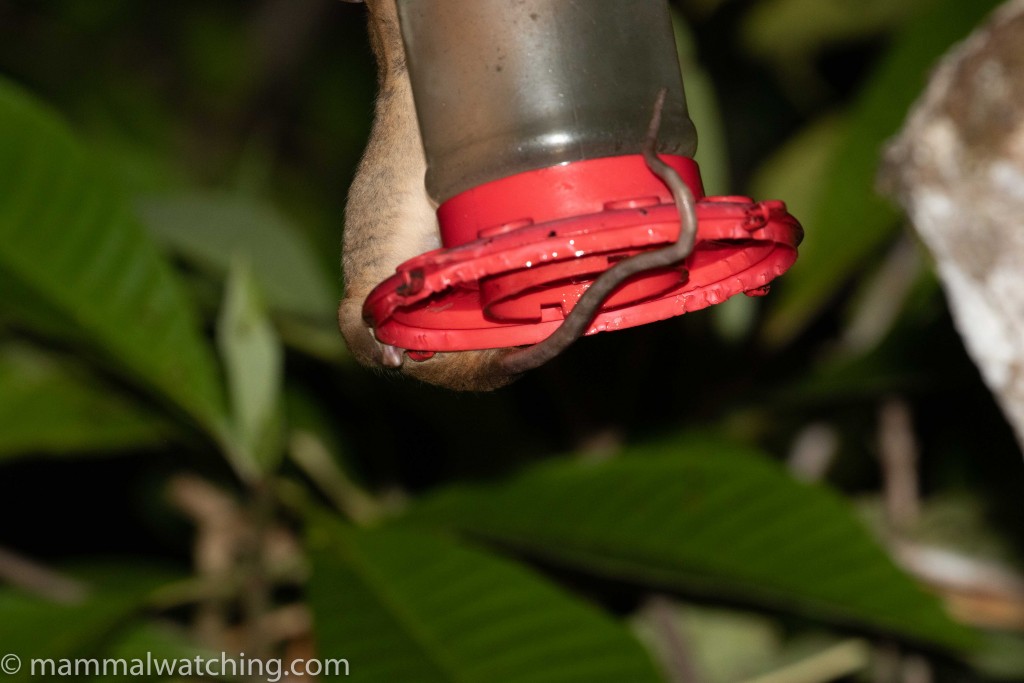
Robinson’s Mouse-Opossum, Marmosa robinsoni. Probably.
It ended up a great evening though it got off to a disastrous start for me when I missed a mouse opossum on the hummingbird feeders after I stopped to take a picture of the bloody moon. Urfff. What was I thinking? I spent the next few hours in a fog of despair, silently cursing my stupidity until we stopped back at the feeders and saw the opossum again. I may have done a little dance. I may also have taken a silent vow never to be distracted by sunsets, full moons, or general scenery again.
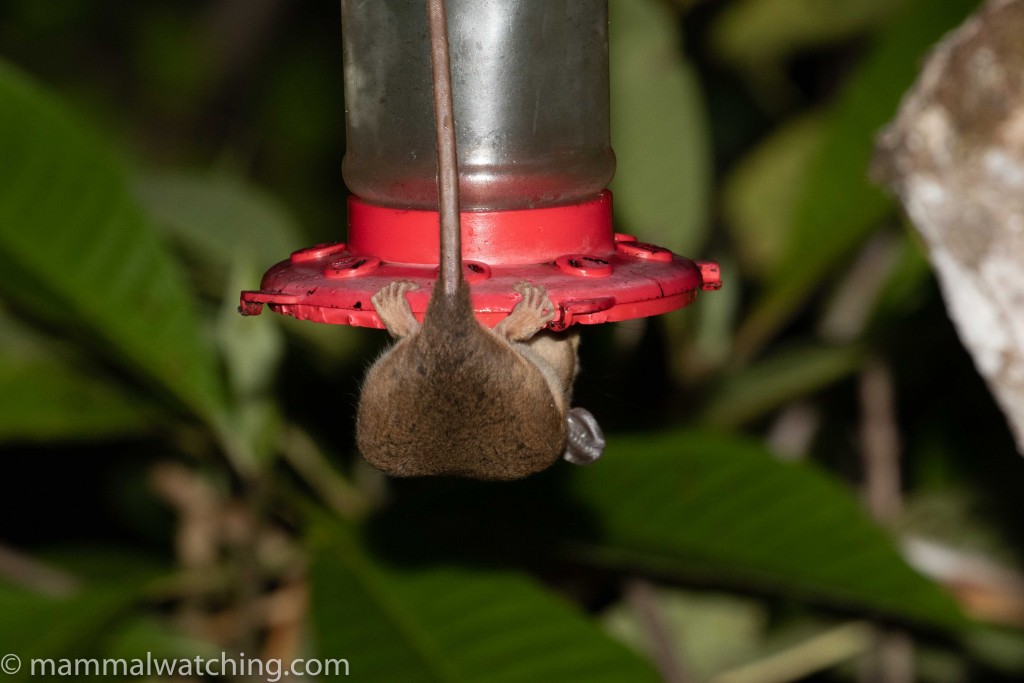
Robinson’s Mouse-Opossum, Marmosa robinsoni. Probably.
I was too slow for good pictures but it was definitely a marmosa species, and Robinson’s Mouse Opossum is the most likely candidate there.
Bats were coming into the feeders too and Fiona Reid helped confirm them as Glossophaga (Long-tongued) bats, and very likely – based on fur and rostrum length – Miller’s Long-tongued Bats. Another lifer.
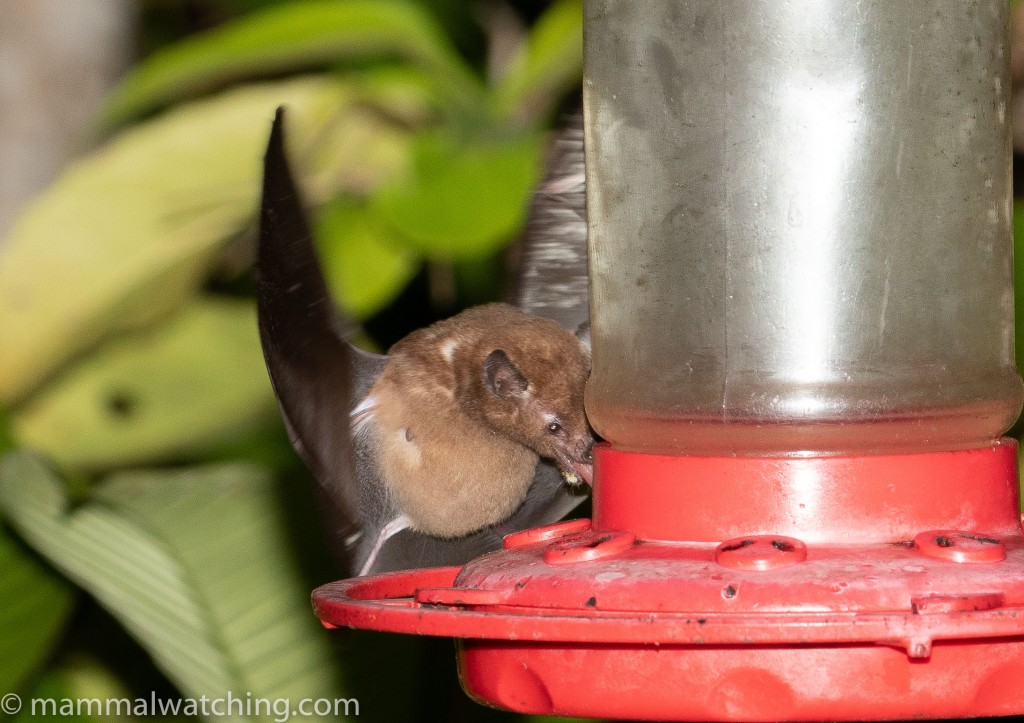
Miller’s Long-tongued Bat, Glossophaga longirostris
Venkat, Ian and I all had thermal scopes with us and I used one to spot a Lesser White-lined Bat, hanging under a leaf (a behavior I hadn’t seen in Saccopteryx species before).
After pretending to get excited by a Vermiculated Screech-owl, our themal scopes picked up heat in a large tree. We had a short but clear look at an Eastern Lowland Olingo, the relatively bushy – and apparently not prehensile – tail was diagnostic.
We thought we had relocated it but instead found another Western Woolly Opossum.
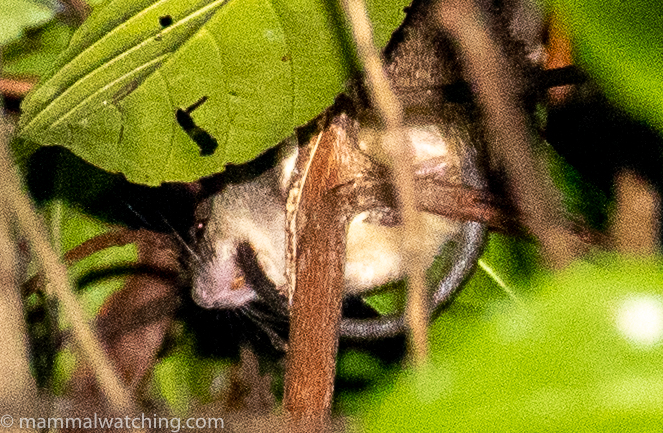
Colombian Soft-furred Spiny Rat, Diplomys caniceps. Probably.
A large rat very high in the canopy was a challenge to photograph. But we eventually got a few photos. The near naked underside of the tail, with a well furred tip, suggests it was a Diplomys species, with the only option there being the little known, and oddly-named, Colombian Soft-furred Spiny Rat.
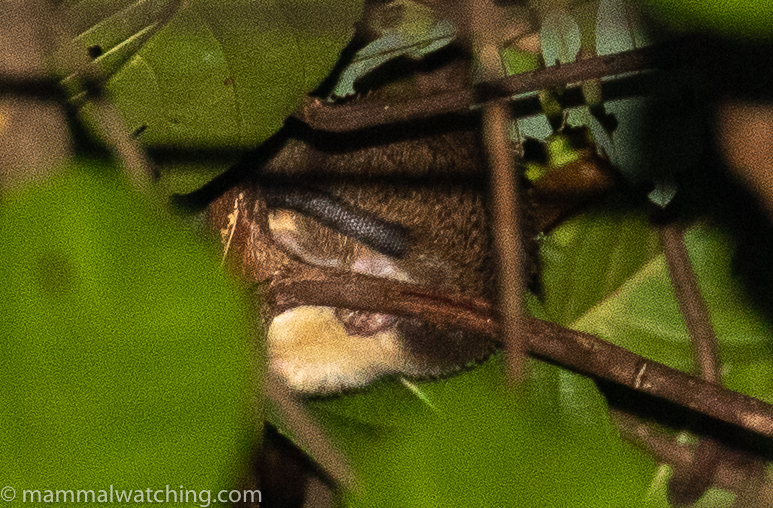
Colombian Soft-furred Spiny Rat, Diplomys caniceps. Probably.
I talked to two experts about the photos. Louise Emmons thought it was either a Diplomys or an Isothrix species (and the latter are not known from the region). But Colombian mammologist Hector Ramirez-Chaves thought the coloration in particular was more typical of a Pattonomys species. I wasn’t sure but Venkat pointed out that much of the flecking on the fur in the picture is an artefact of a heavily cropped very high ISO shot, and so we both felt Diplomys was a better fit, not least because Pattonomys rats seem to have naked tail tips. Of course – and as always – if anyone thinks different then let me know!

January 11. A predawn walk produced little other than another Brown-eared Woolly Opossum and a Proechimys rat that Venkat Ian and Rob saw, with Boyacá Spiny Rat (P. chrysaeolus) the most likely suspect.
I nearly had a heart attack when I discovered I had lost the memory card from my camera. Search parties were dispatched until I realized that the camera I had been examining was Rob’s not mine. I blame lack of sleep and PTSD from Moon Photogate.
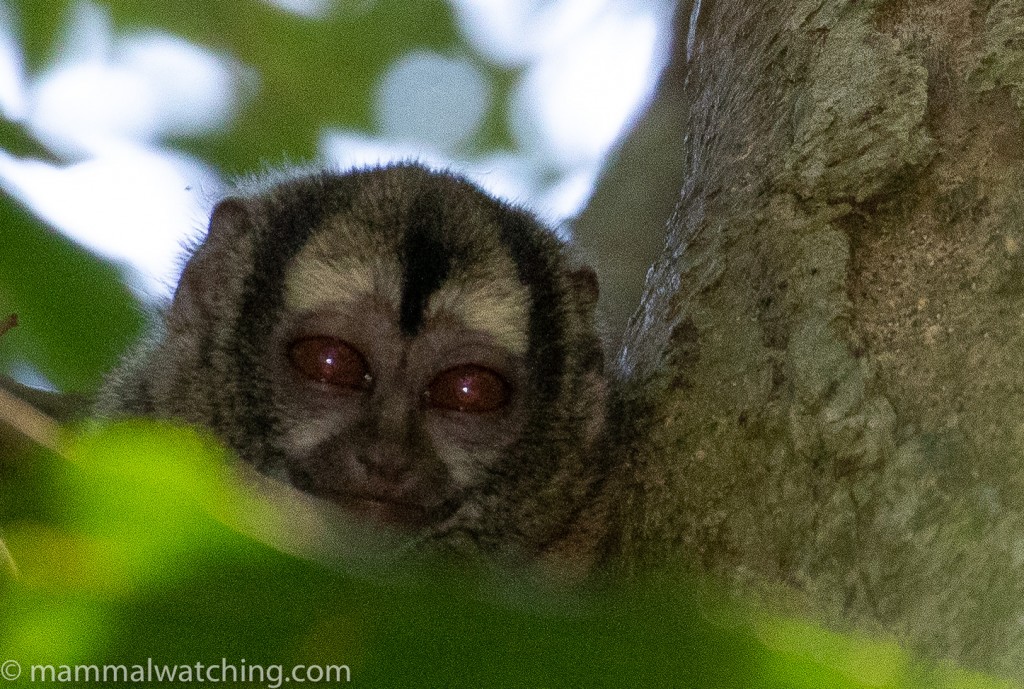
Grey-handed Night Monkey, Aotus griseimembra
After breakfast Jose, the camp manager, took us to see a roost of Grey-handed Night Monkeys close to the accommodation.
We spent the rest of day looking for the spider monkeys. Jose thought our best bet would be to walk the road outside the park in the early morning. In the afternoon they would be more likely at their regular hangout close to a creek in the reserve, at the bottom of the hill. Indeed, Jose had seen the monkeys there the afternoon we arrived and so we were kicking ourselves for not checking the area on our way in.
But neither strategy was successful. The road was quiet in the morning and staking out some of the monkey’s favorite trees near the creek for a couple of hours in the afternoon wasn’t successful either though we heard some animals calling in the distance.

Spot the Spider Monkey
Now very much in the Last Chance Saloon, we visitef a viewing platform for the last hour of light hoping we might spot them. There was neither sight nor sound.
And then there was the sort of miracle that could start a new religion. Rob saw a very distant animal in the canopy. An extraordinarily lucky – and sharp-eyed – spot. And we had a brief but clear look at a Spider Monkey moving along a branch in a tree that might have been a kilometer away.
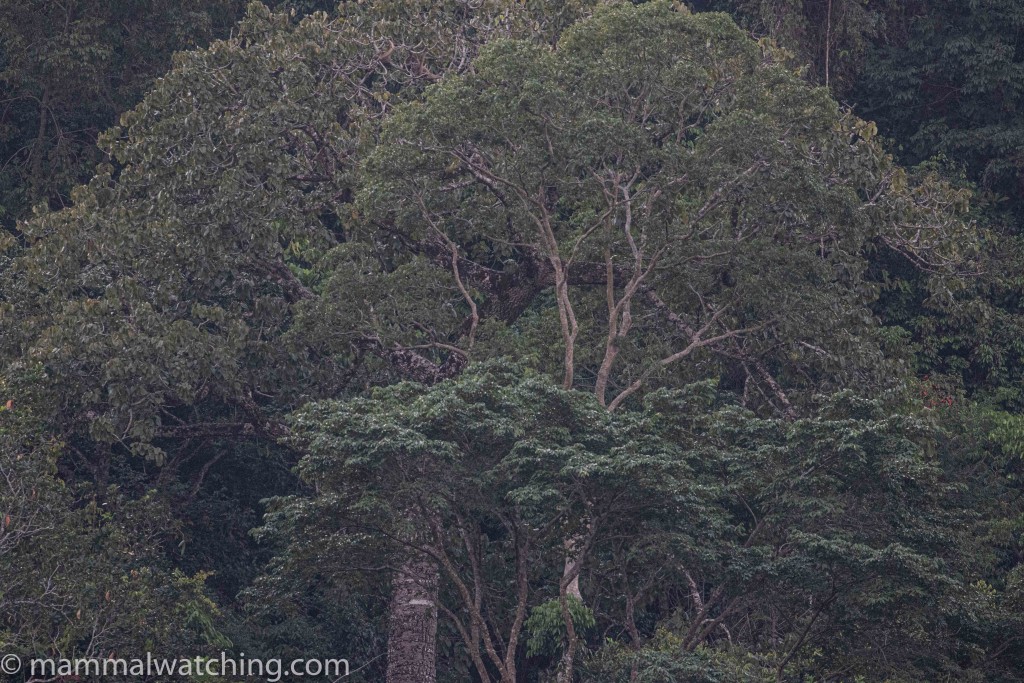
Monkey tree
I returned to camp, and the monkeys resurfaced before sunset in the same tree and sat out in the open. Venkat and his magical camera managed to get some record shots.
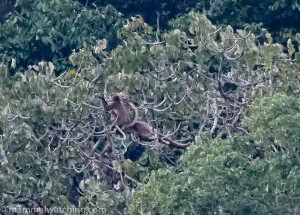
Brown Spider Monkey, Ateles hybridus. Photo Venkat Sankar.
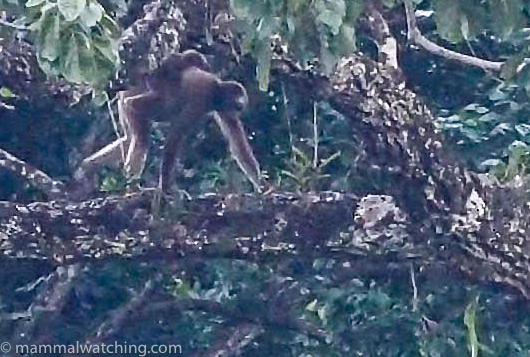
Brown Spider Monkey, Ateles hybridus. Photo Venkat Sankar.
I caught a myotis – most probably a Riparian Myotis though I would needed to have cheeped the teeth to be sure – in a hand net. It was roosting in the thatch of the restaurant roof.
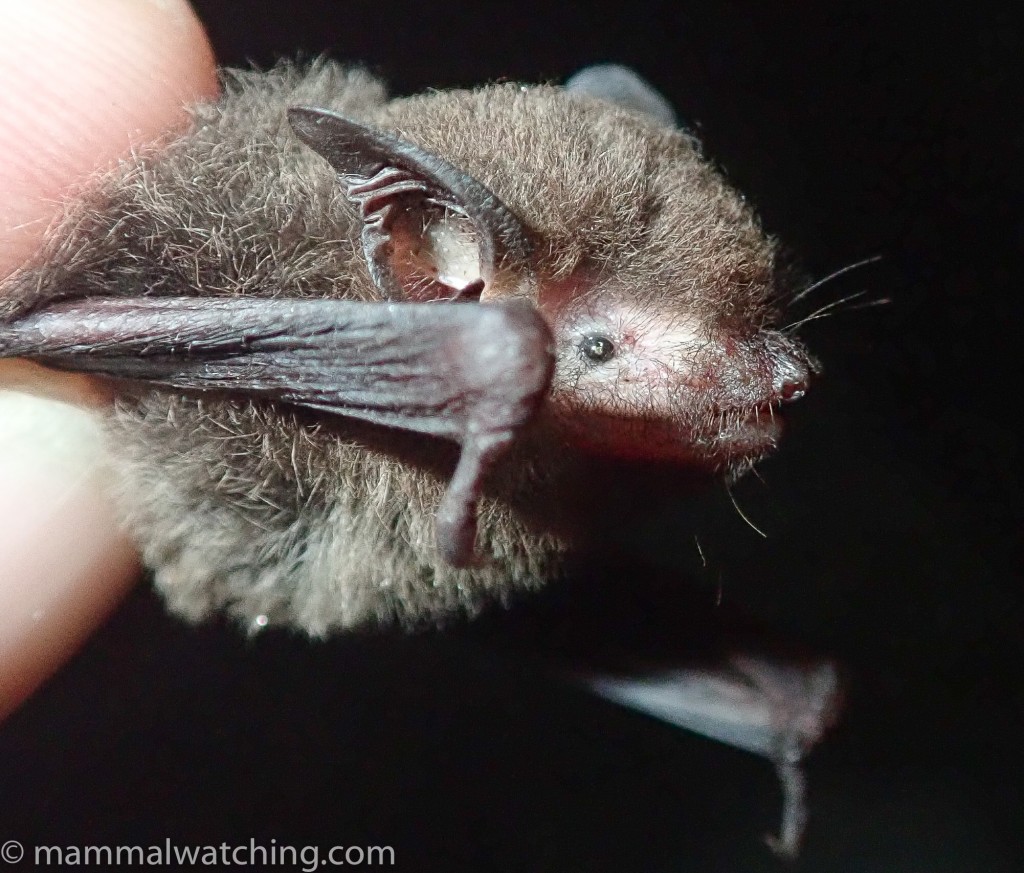
Riparian Myotis, Myotis riparius. Probably
Spotlighting that evening was quiet, probably because we were tired. THough we did see a Crab-eating Fox near the kitchen.
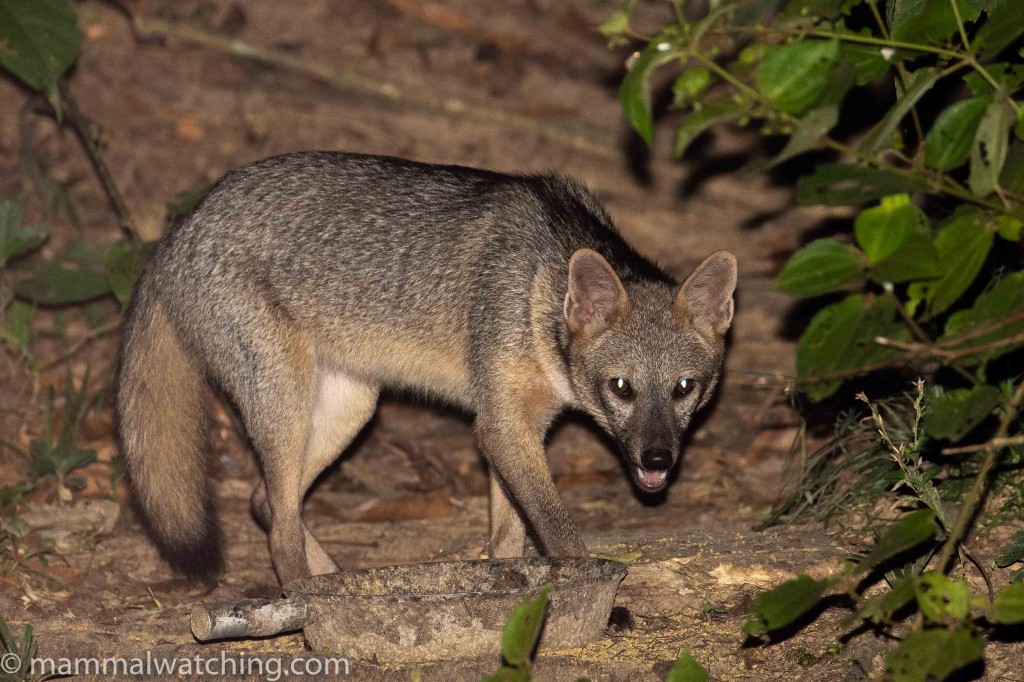
Crab-eating Fox, Cerdocyon thous
January 12. An early morning walk along the road looking for Brown Spider Monkeys produced a very localized Santander Dwarf Squirrel close to the entrance gate. Only Venkat was quick enough to get a photo. Are you spotting a pattern here?
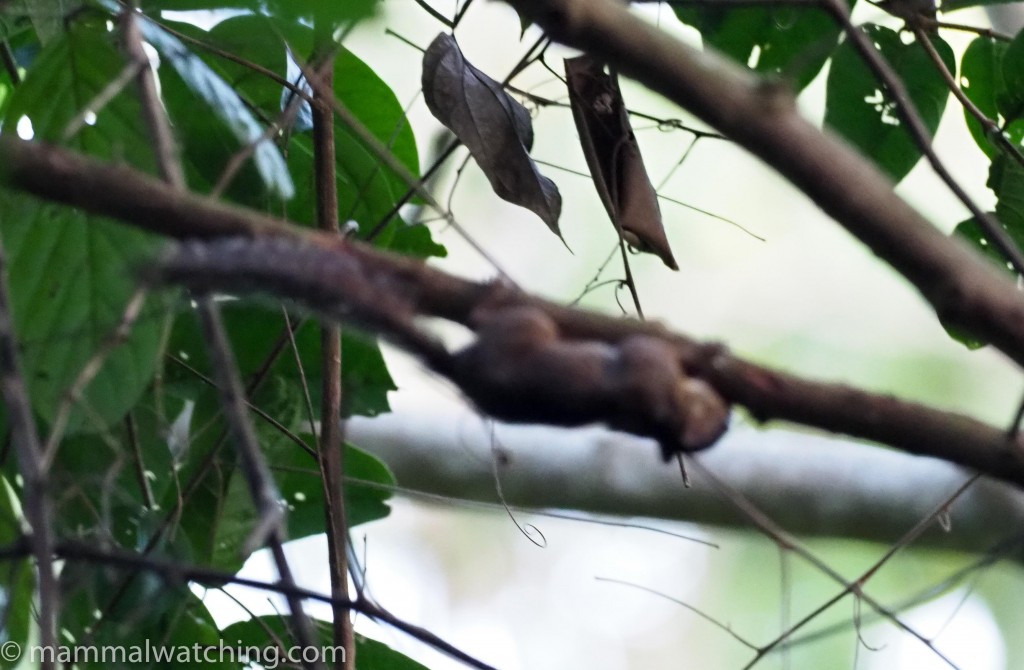
Santander Dwarf Squirrel, Microsciurus santanderensis
And then Hari spotted a large troop of very relaxed Varied White-fronted Capuchins along the road.
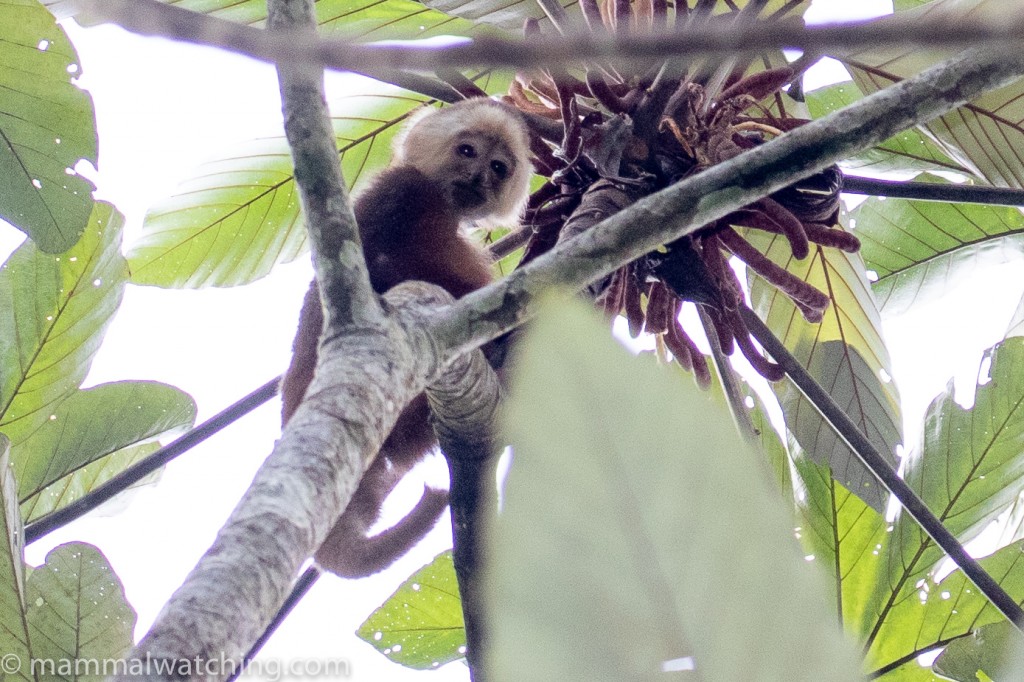
Varied Capuchin, Cebus versicolor
We heard Colombian Red Howlers calling close by but couldn’t see them.
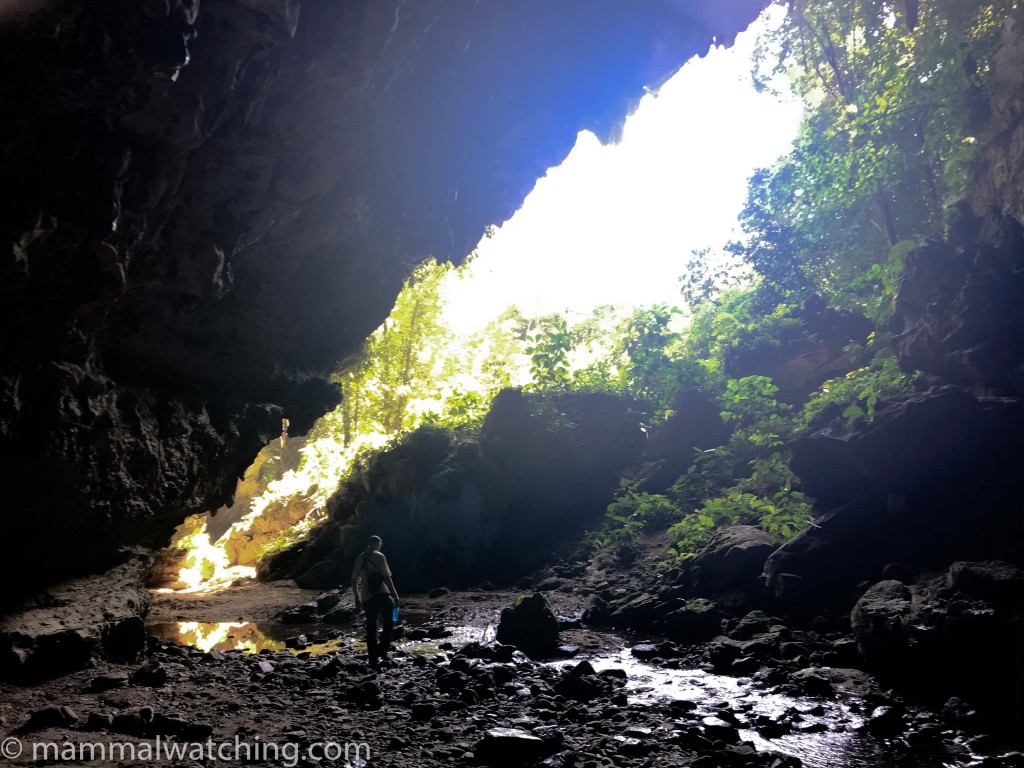
We stopped at some caves near the Rio Claro Nature Reserve on the drive back to Medellin. A half hour walk along a creekside trail took us to an enormous cave that is best known as home to Oilbirds. More importantly it had bats. But getting into the main chamber required wading through waist deep water. We settled for a look and listen to the very weird Oilbirds, and photographed a few Jamaican Fruit-eating Bats.
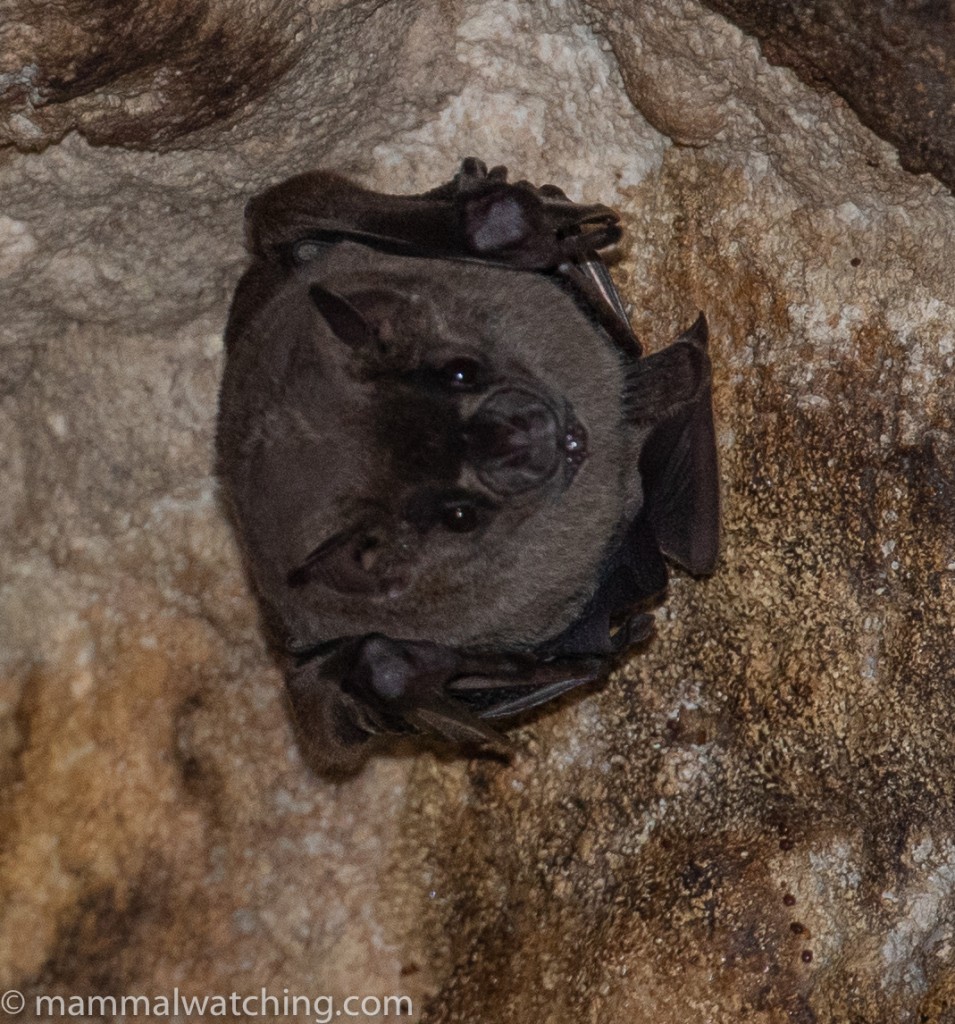
Jamaican Fruit-eating Bat, Artibeus jamaicensis
And then it was back to Medellin airport for a flight to Bogota and the end of the main tour. Martin and Becky connected on to Santa Marta for a few days of luxurious monkey spotting on the beach while Rob, Cheryl and I stayed in Bogota for the night before three more days of monkey searching around San Jose del Guaviare.
Post Trip Extension to San Jose del Guaviare
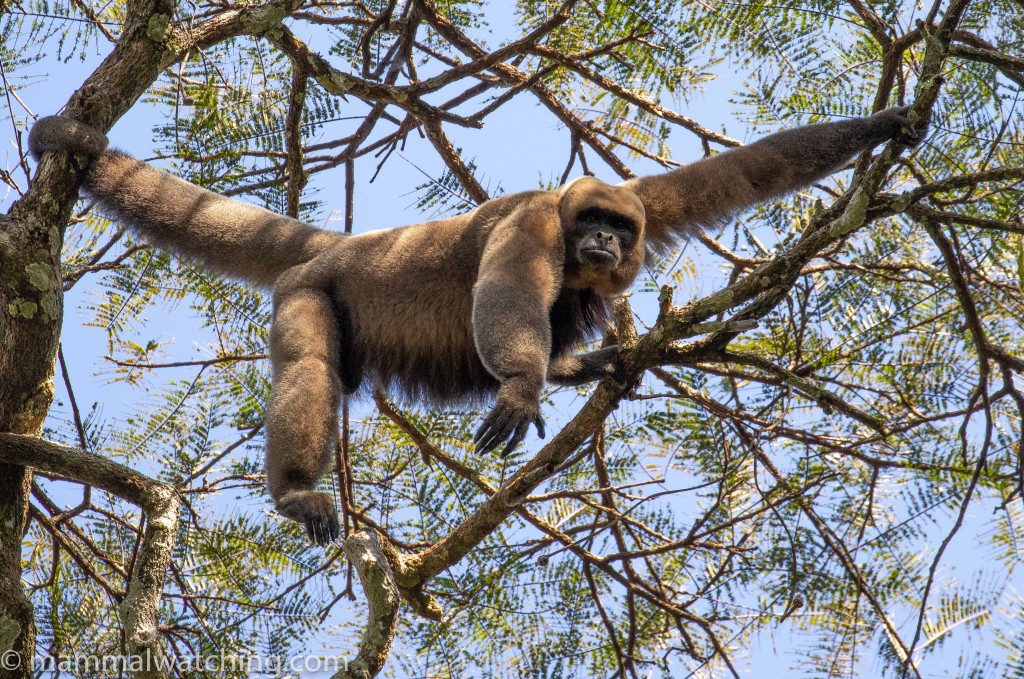
Common (Brown) Woolly Monkey, Lagothrix lagotricha
Cheryl Antonucci, Jon Hall, Rob Smith
January 13. Rob had hoped to fly down to San Jose del Guaviare from Bogota but the ever-shifting timetable was against us: today’s flight left in the late afternoon and we would lose a whole a day in the field. So we decided to drive and left the hotel at 4 a.m. I woke up somewhere around Villavicencio, three hours later and halfway to our destination.
In the late morning we meet up with Miguel and Cesar, our local guides based in Guaviare, and they led the way on their motorbike to the small finca we would be staying at for the next two nights.Both were excellent spotters and about half an hour from the farm they stopped for our first monkeys. Black – or Collared – Titis, one of the three key targets for this bit of the trip.
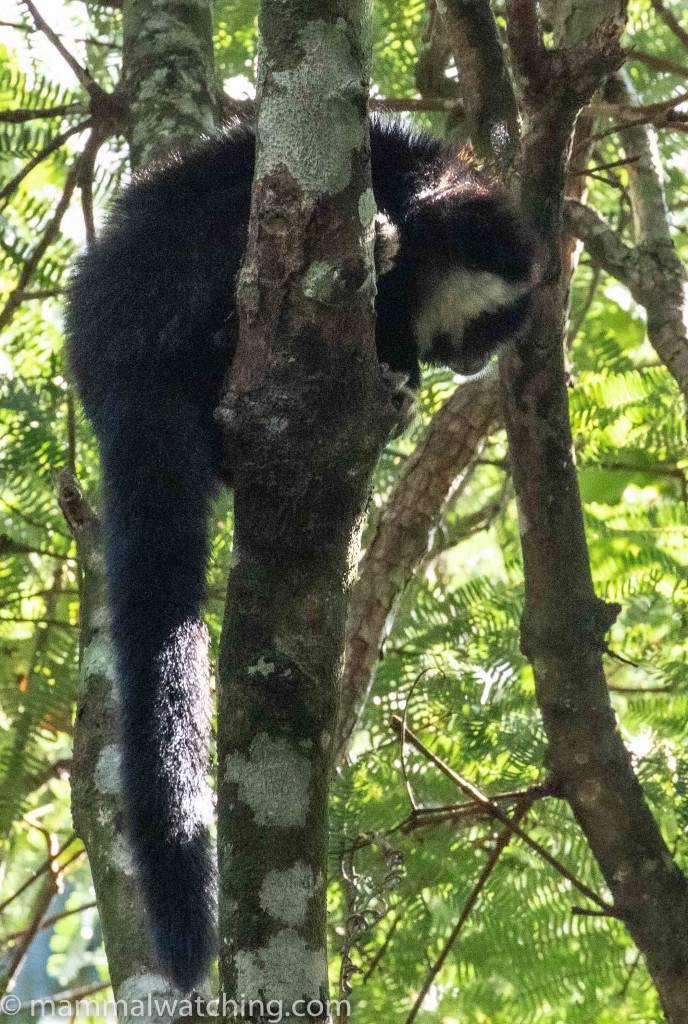
Collared (Black) Titi, Callicebus lugens
In very quick succession we saw our first Colombian Red Howlers of the trip,
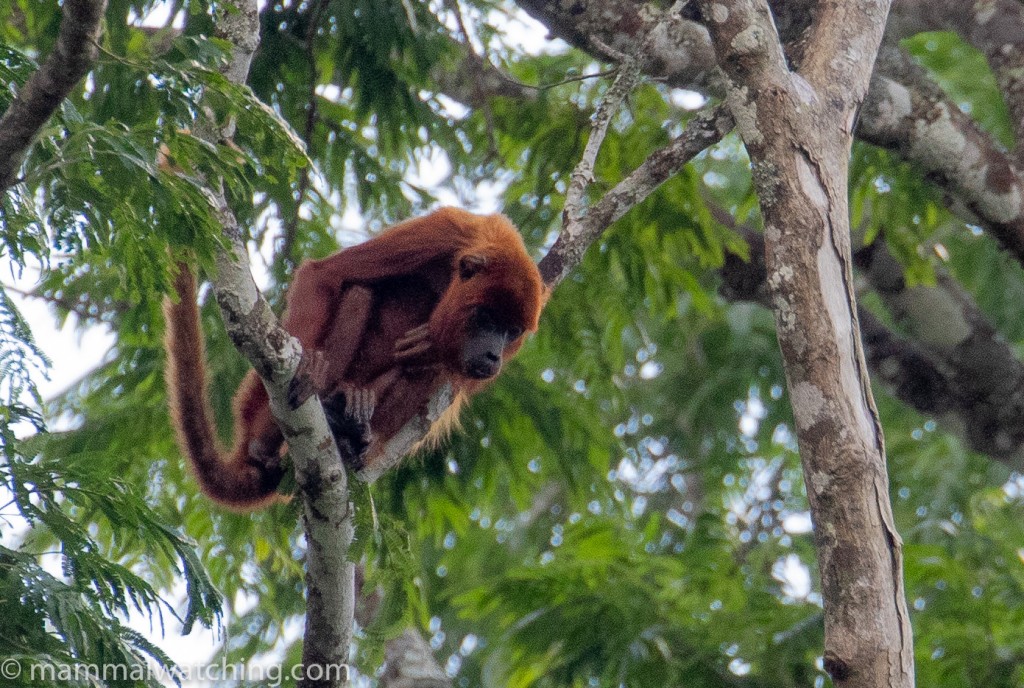
Colombian Red Howler, Alouatta seniculus
some Tufted Brown Capuchins,
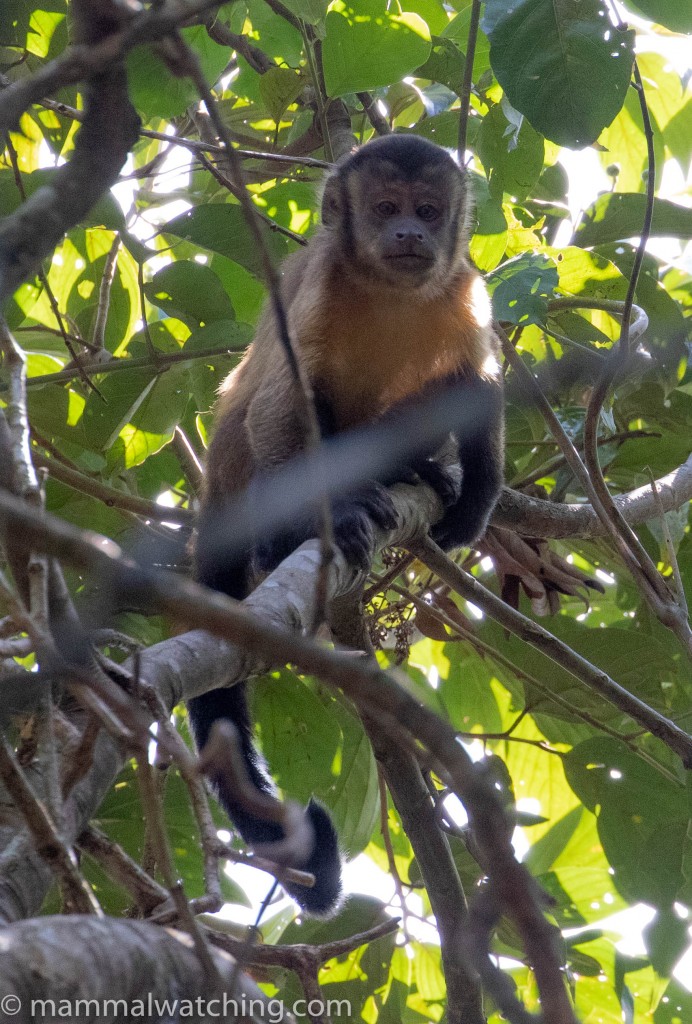
Tufted (Large-headed) Capuchin, Sapajus (macrocephalus) apella
a troop of Common Squirrel Monkeys
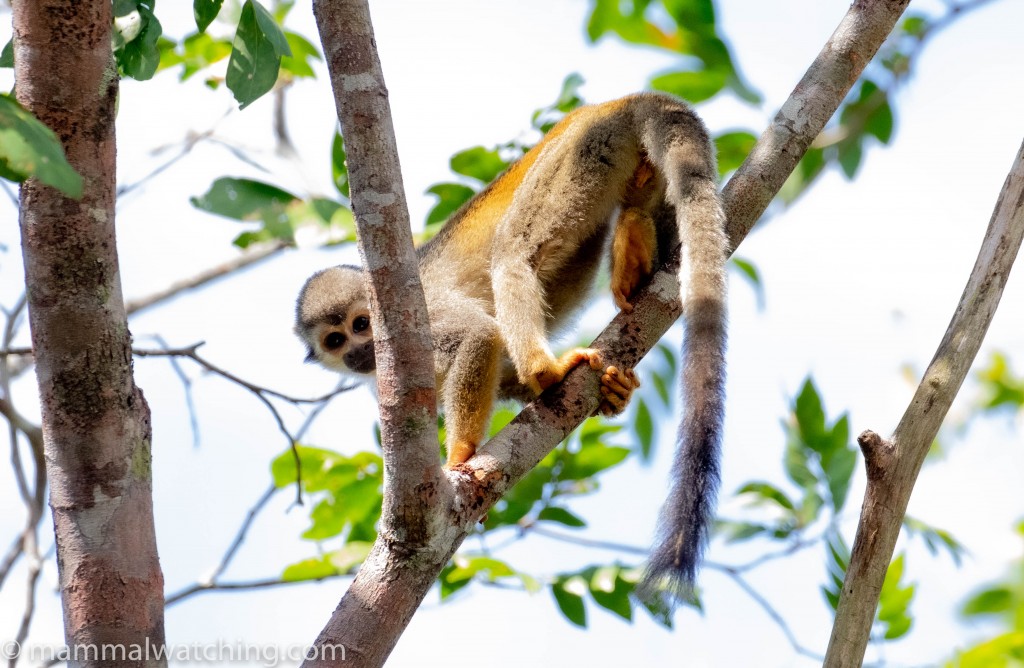
Common Squirrel Monkey, Saimiri sciurus
some very relaxed Common Woolly Monkeys,
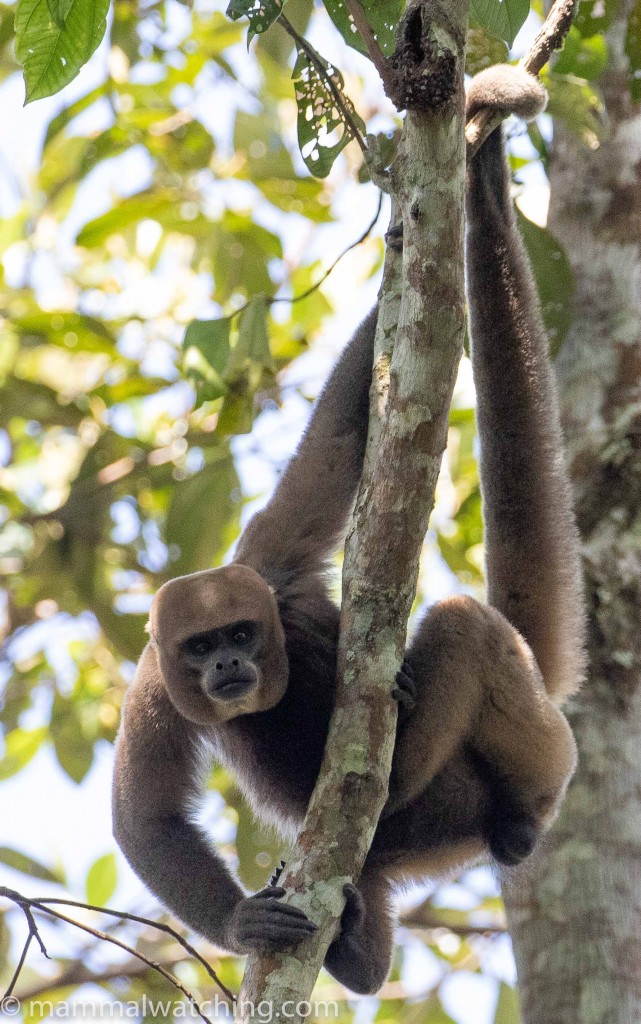
Common (Brown) Woolly Monkey, Lagothrix lagotricha
and – another key goal – the impish looking Mottle-faced Tamarins (or Diablitos as the locals more creatively call them).
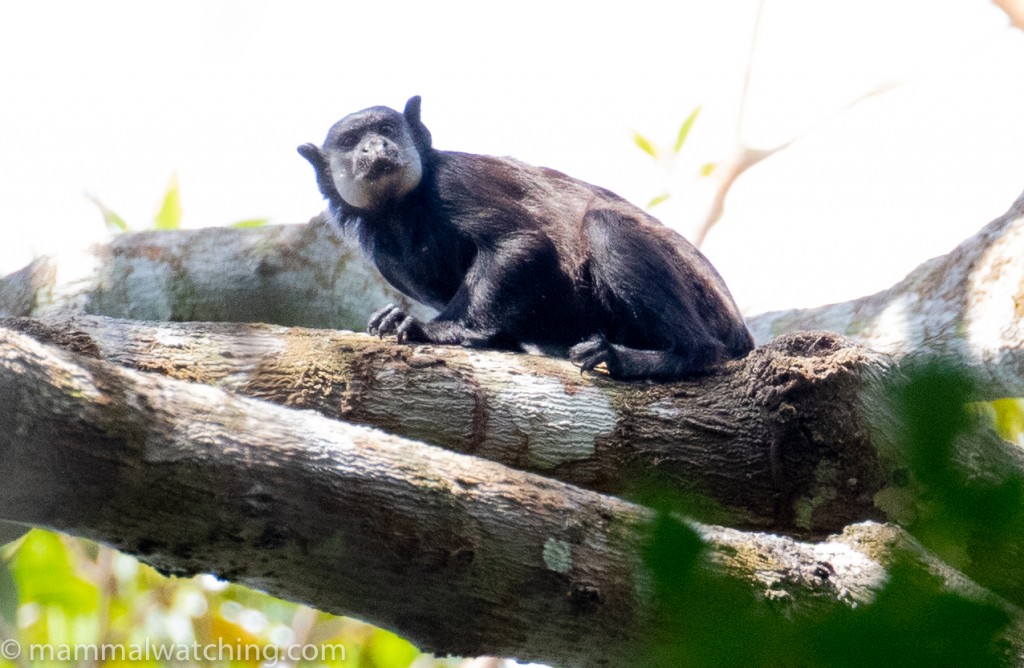
Mottle-faced Tamarin, Saguinus inustus
It would be hard to describe them as cute but they were certainly remarkable.
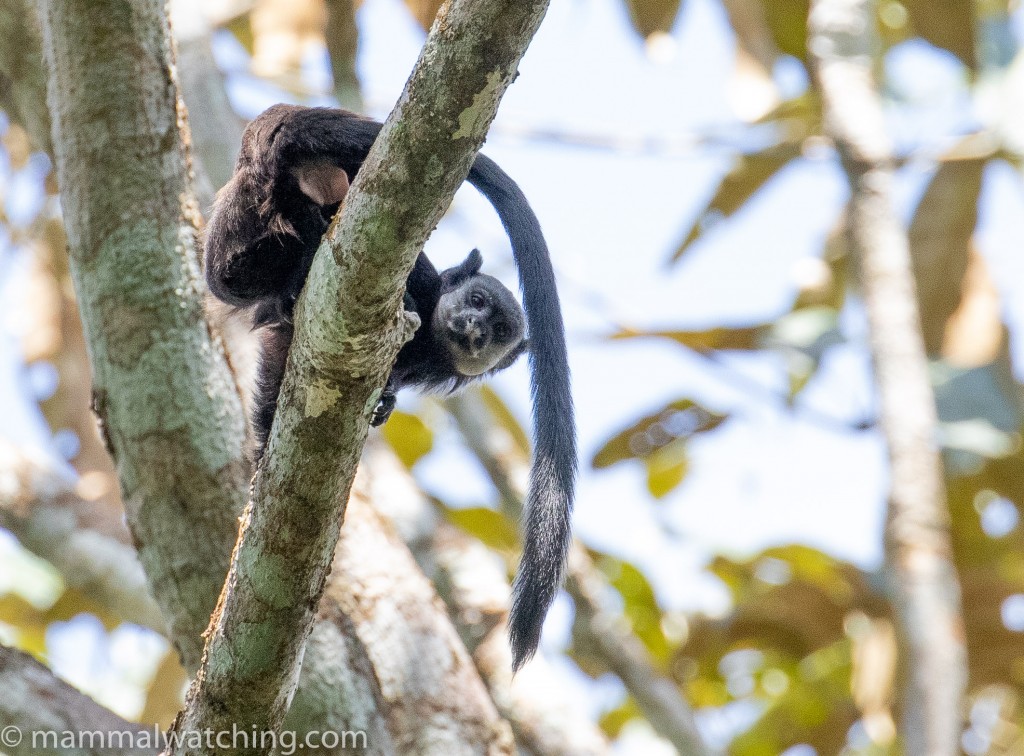
Mottle-faced Tamarin, Saguinus inustus
Delighted with the primate-packed morning we arrived at the finca, perched on a small hill with a very welcome breeze. We were the first guests ever to stay and they were busy constructing our beds as we checked in.
It was simple accommodation, but the owners were extremely welcoming. As were the menagerie of orphaned animals including Mowgli, an affectionate capybara, and Hercules, a self-indulgent young Tapir who spent most of his time cajoling the Capybara, assorted Peccaries and us, into rubbing his stomach.
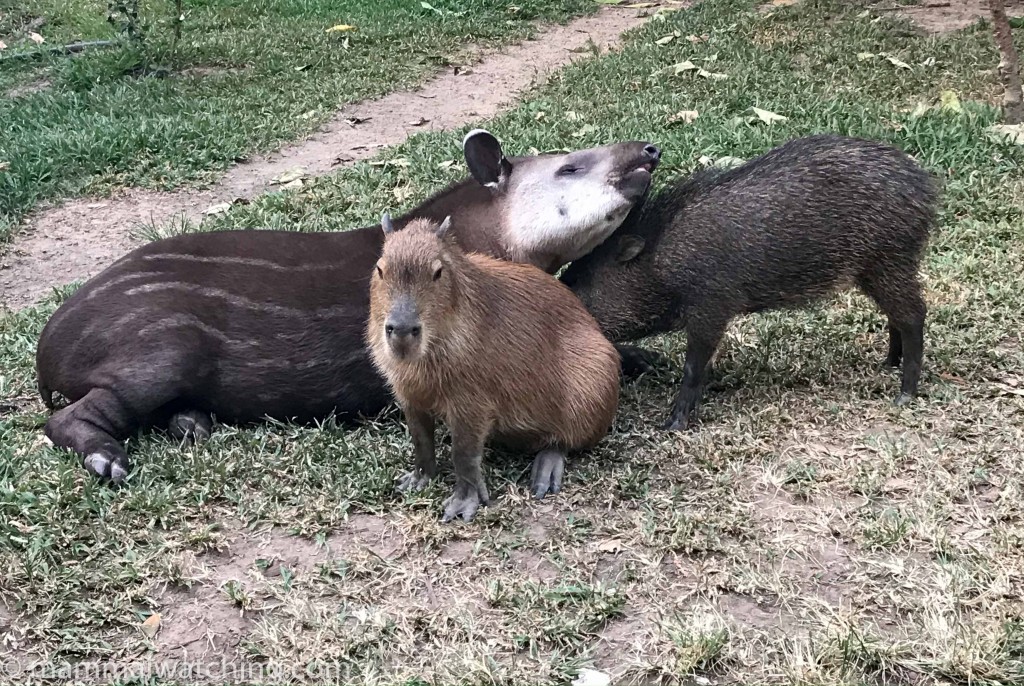
Hercules, Mowgli and a Peccary
A lovely animal, and also – judging by his ability to get through every locked door on the property – an intelligent one.
We looked for more monkeys in the late afternoon but saw only Common Squirrel Monkeys. An hour along the road after dark produced a single Great Fruit-eating Bat (Artibeus lituratus) on a tree trunk and a small arboreal mouse, that was most likely Oecomys bicolor.
January 14. We spent our last full day around a Cerro Azul, a site that protects ancient rock art and the forest around it.
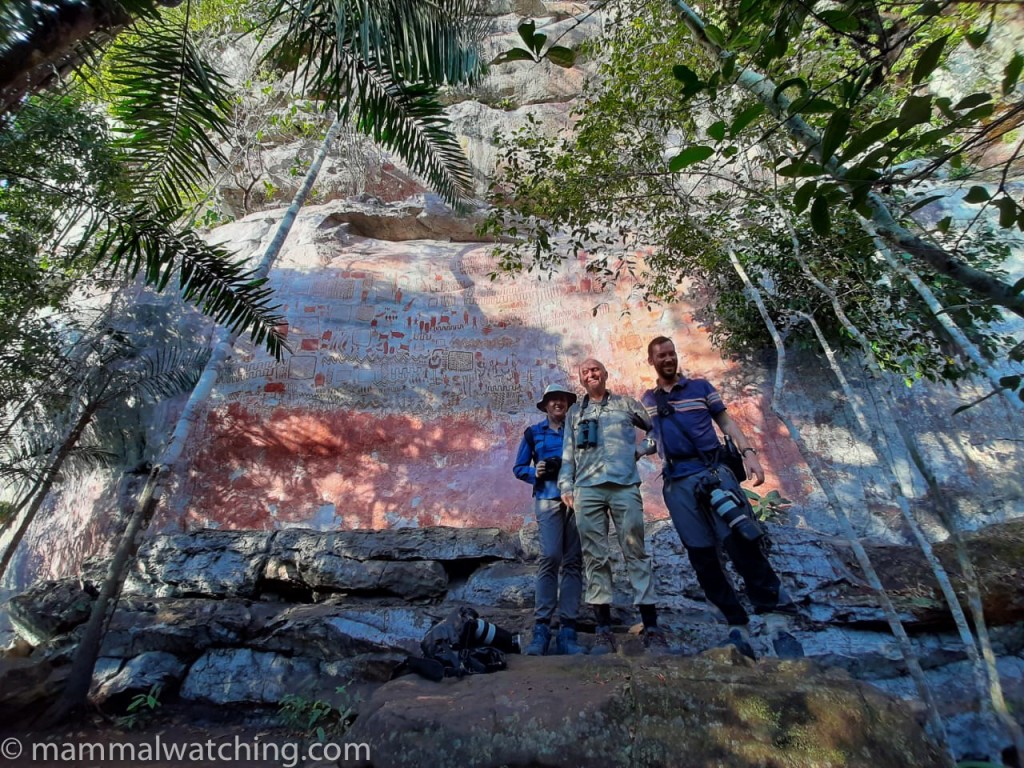
Base camp was at a farmhouse next to the reserve, across whose land you have to travel to enter the forest. After the obligatory sickly sweet cup of coffee, we were led along a vague trail through partially flooded forest. Our main goal here were the Golden-backed Uakaris.
It took an hour to reach some taller forest but as soon as we did we spotted an Uakari.
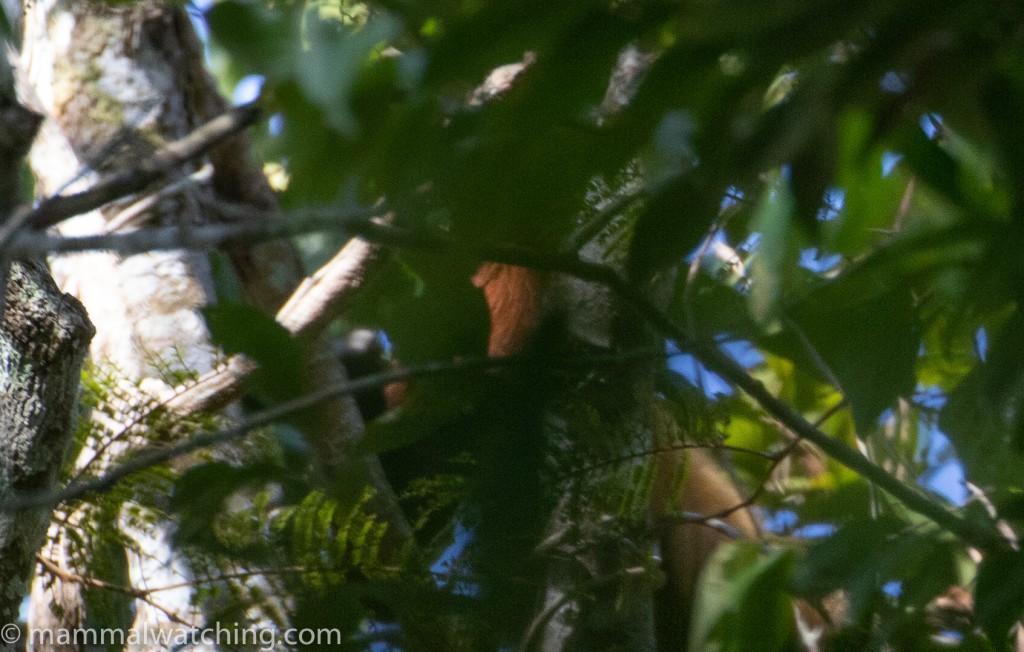
There are record shots… and then there is this! The blob of color is a Uakari. Honest.
We also spotted many ridiculously relaxed Common Woolly Monkeys.
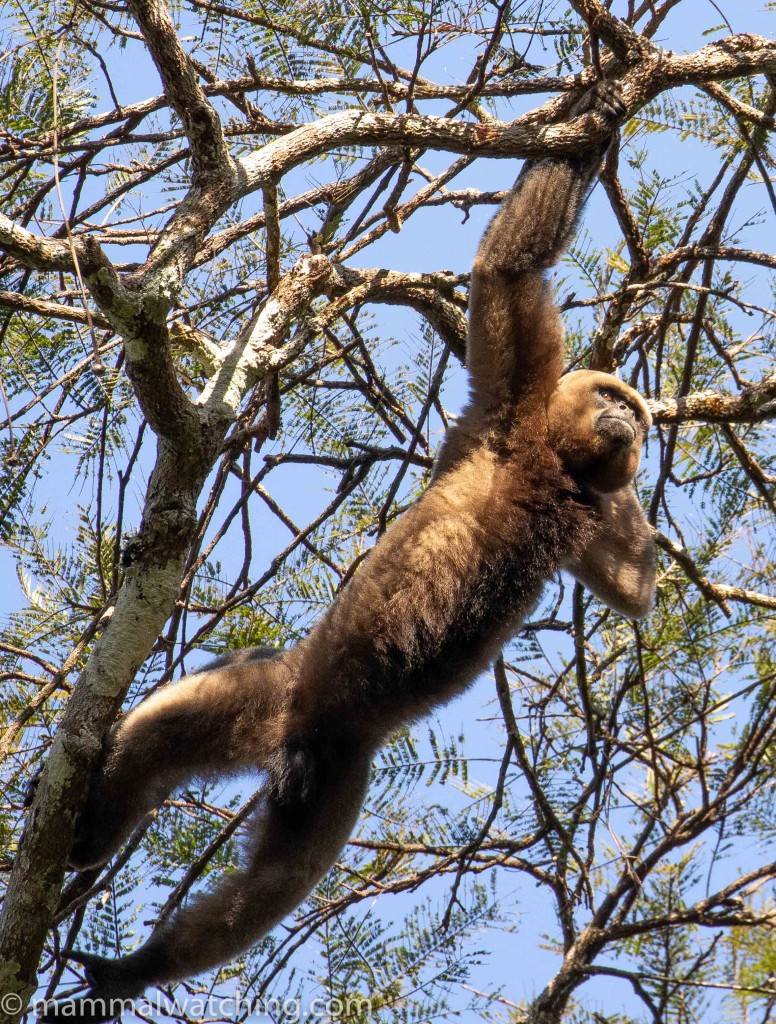
Common (Brown) Woolly Monkey, Lagothrix lagotricha
The Uakaris were not so relaxed and though we had repeated views of several animals, none was long enough to photograph remotely well. Most authorities treat the Uakari here as a subspecies of Black Uakari (Cacajao melanocephalus) that I had seen near Manaus. But at least one scientist has proposed splitting the species into Golen-backed Uakari (C. ouakary). We will see,,,,
Though the uakaris were shy the woolly monkeys were most certainly not. And todemonstrate their utter brazenness, a pair proceeded to mate in a tree directly above us. For at least 5 thrusting minutes.
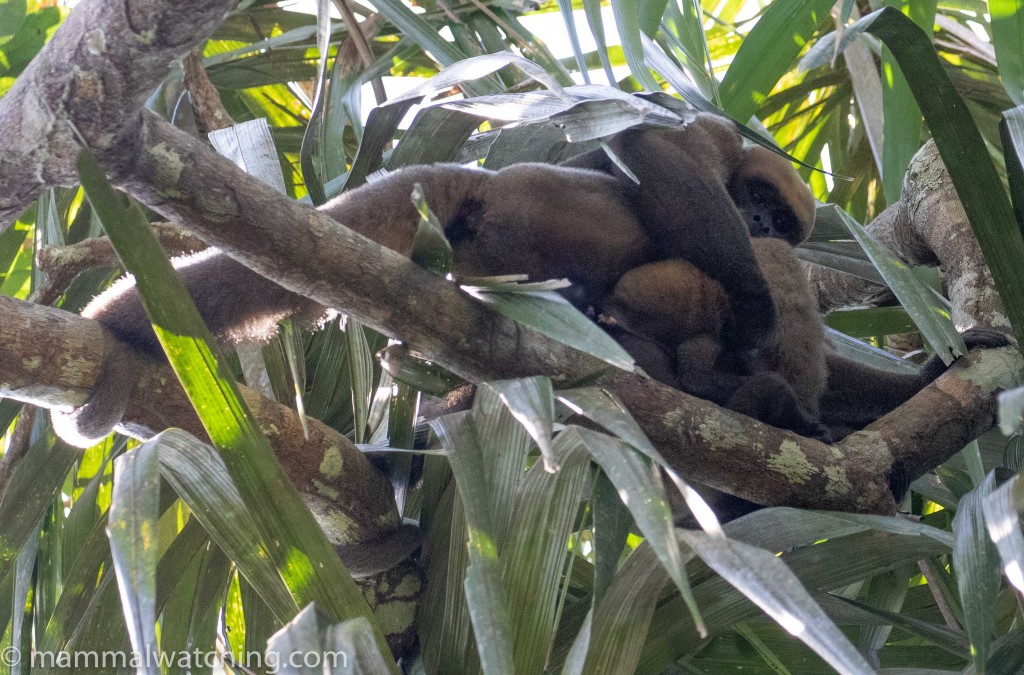
Monkey Porn
The male held eye contact with us the whole time and our viewing angle ensured that nothing was left to anyone’s imagination. Tired of their exhibitionism I played some romantic mood music and they ended the show. But the pair lounged above us, in post coital bliss, for another 30 minutes.
We took various video that our local guides dubbed “porno mico” when they repeated the story (many many times) to just about everyone we met that day. And the day after.
It was as hot as the monkey sex, and so, satisfied with the morning, we returned to the farm to relax.
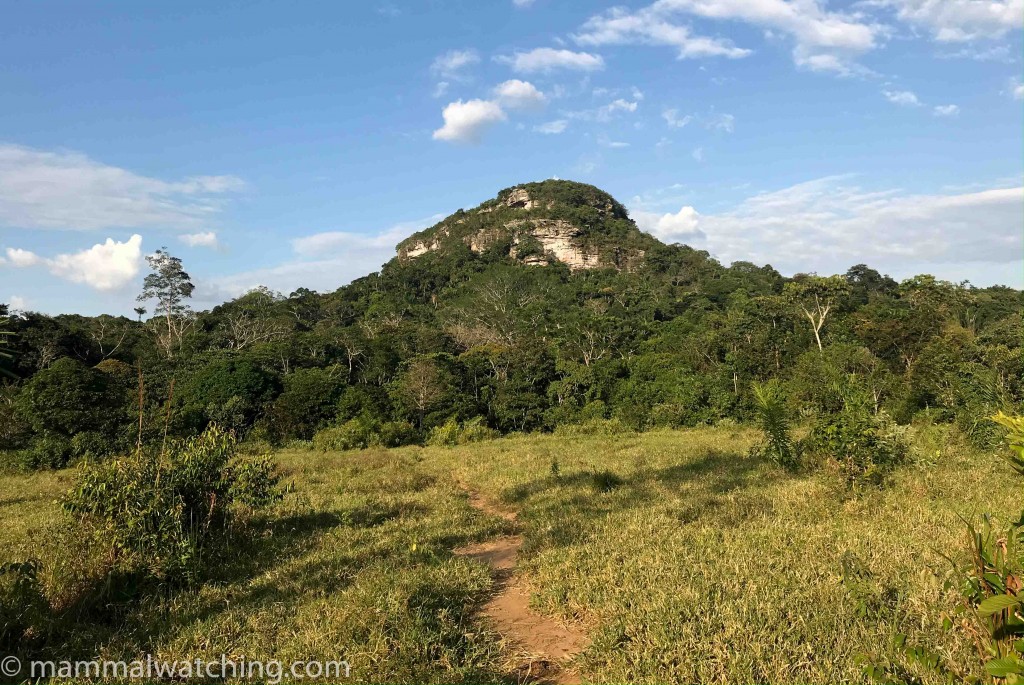
After lunch we took a stroll through some woodland near a neighboring farm, hoping to get another look at the Mottle-faced Tamarins. We saw more Collared Titis, Squirrel Monkeys and Red Howlers but no tamarins.
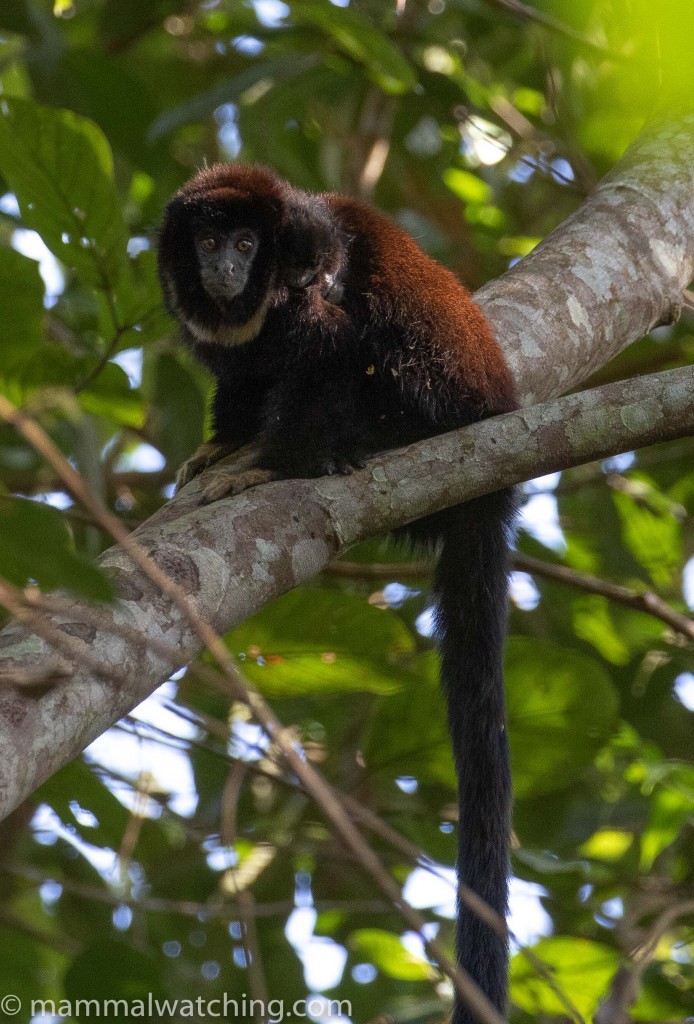
Collared (Black) Titi, Callicebus lugens
The last couple of hours of daylight were spent around the impressive rock art and a cave close by. A fabulous cave that you can follow for a couple of hundred metres through to a second entrance close to the trail. It was full of bats with a good diversity of species.
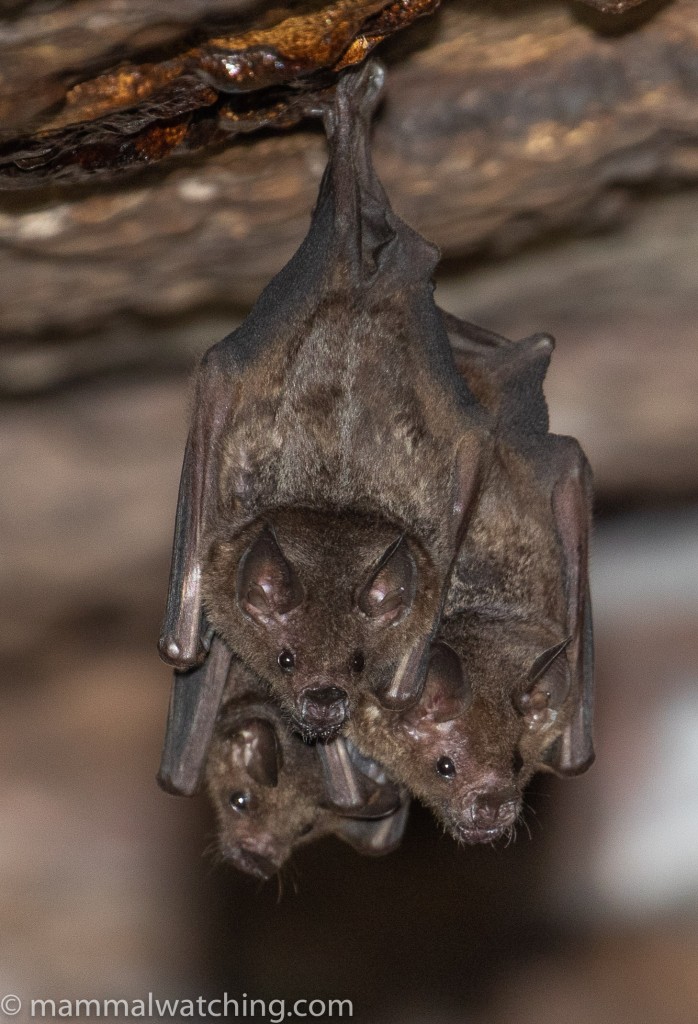
Silky Short-tailed Bat, Carollia brevicauda
There were plenty of Silky Short-tailed Bats and possibly a second Carollia species.
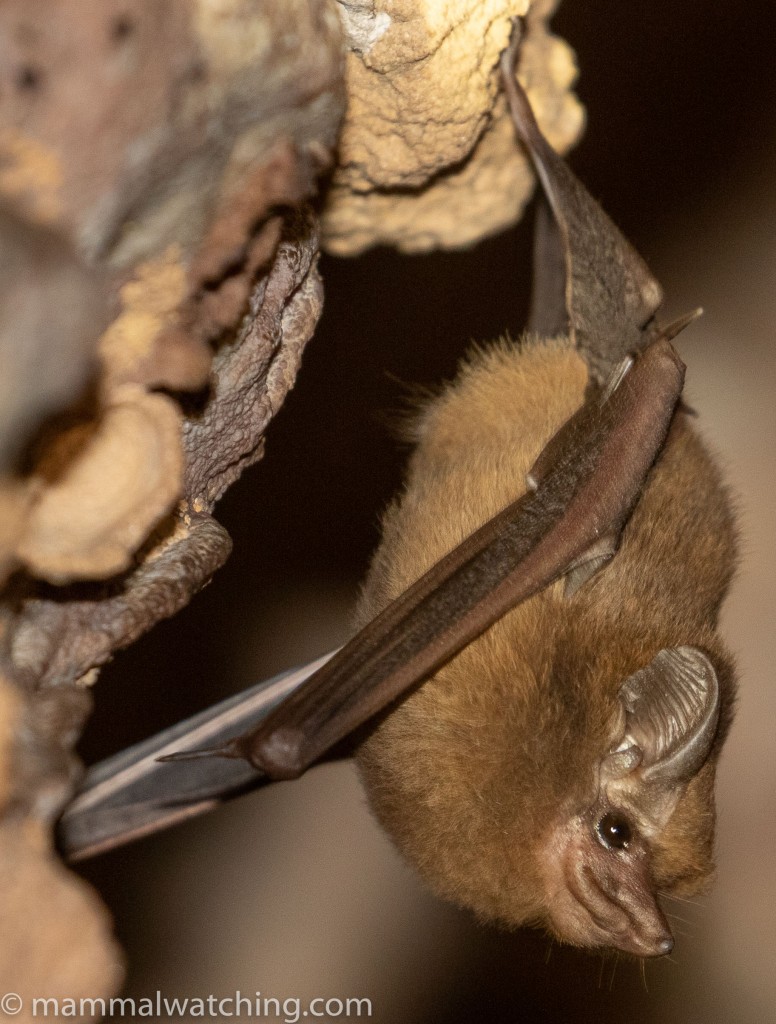
Lesser Dog-like Bat, Peropteryx macrotis
And both Lesser and Greater Dog-like Bats.
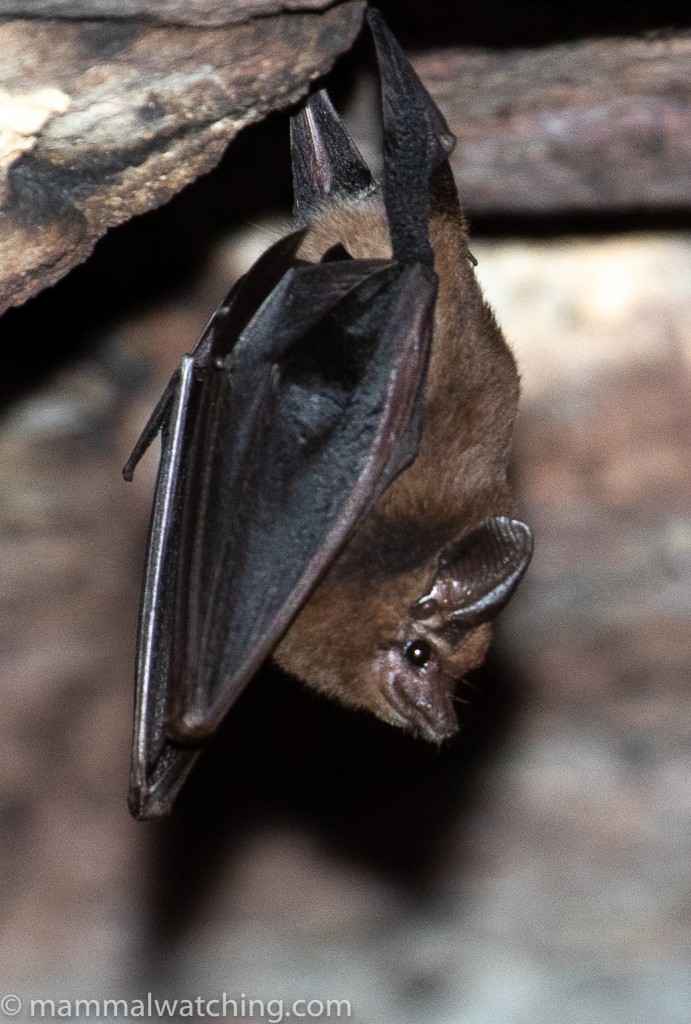
Greater Dog-like Bat, Peropteryx kappleri
A cluster of Lesser-spear Nosed Bats were nice to see.
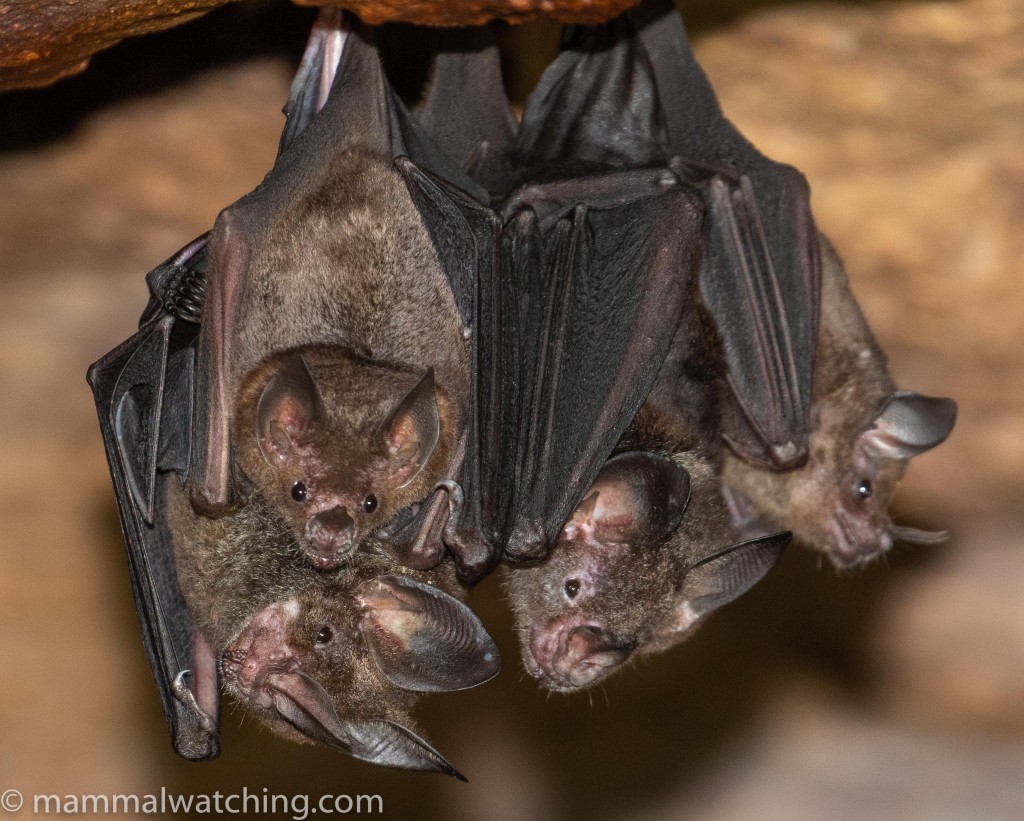
Lesser Spear-nosed Bats, Phyllostomus elongatus
As were many Common Vampire Bats, which I tried hard and unsuccessfully to turn into White-winged Vampire Bats.
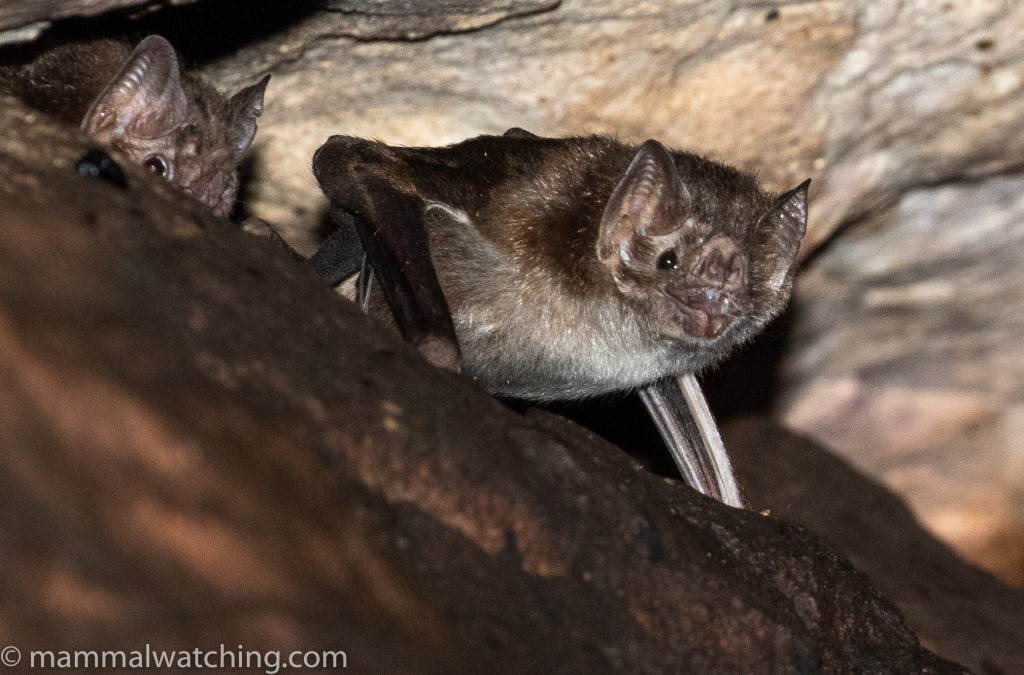
Common Vampire Bat, Desmodus rotundus
Best of all was one of my favorite neotropical bats, a Striped Hairy-nosed Bat. Quitea an uncommon and very cool looking species.
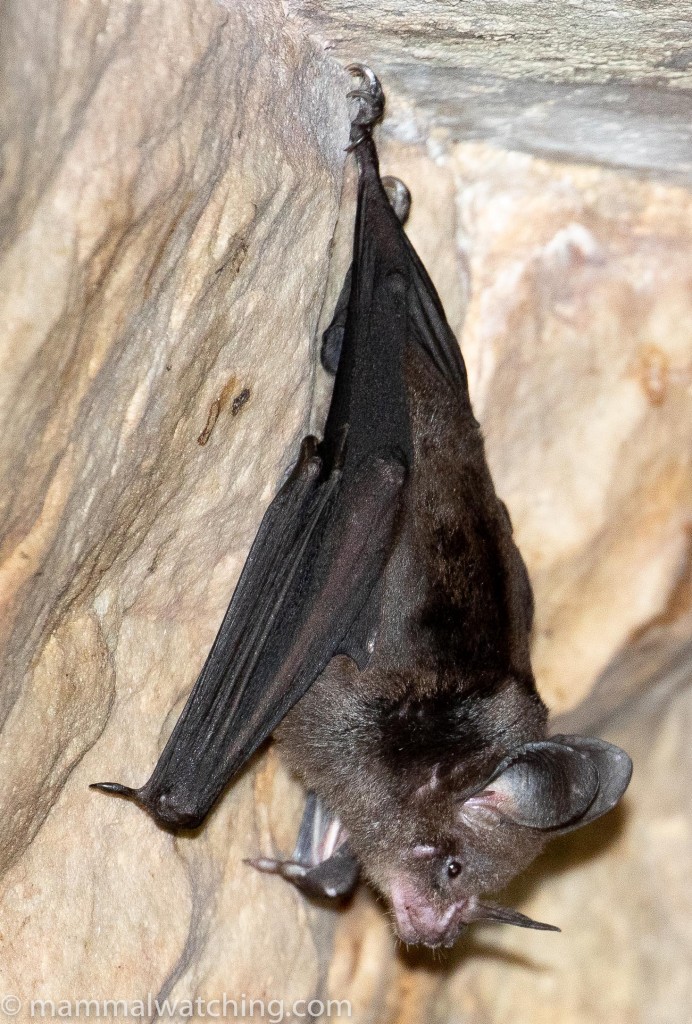
Striped Hairy-nosed Bat, Gardnerycteris crenulatum
Our guide spotted an armadillo after sunset, probably a Nine-banded Armadillo. After dinner at the farm we returned to the village near our accommodation for a well-earned beer.
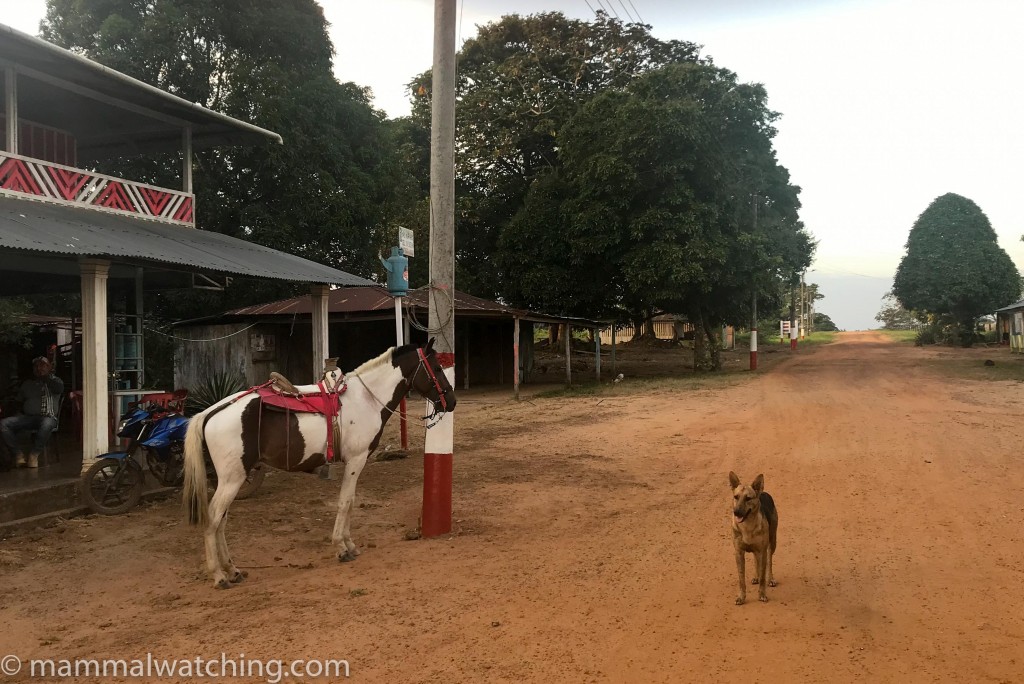
One horse town
This being the last night we decided to have a beer in every pub in town. Both of them.
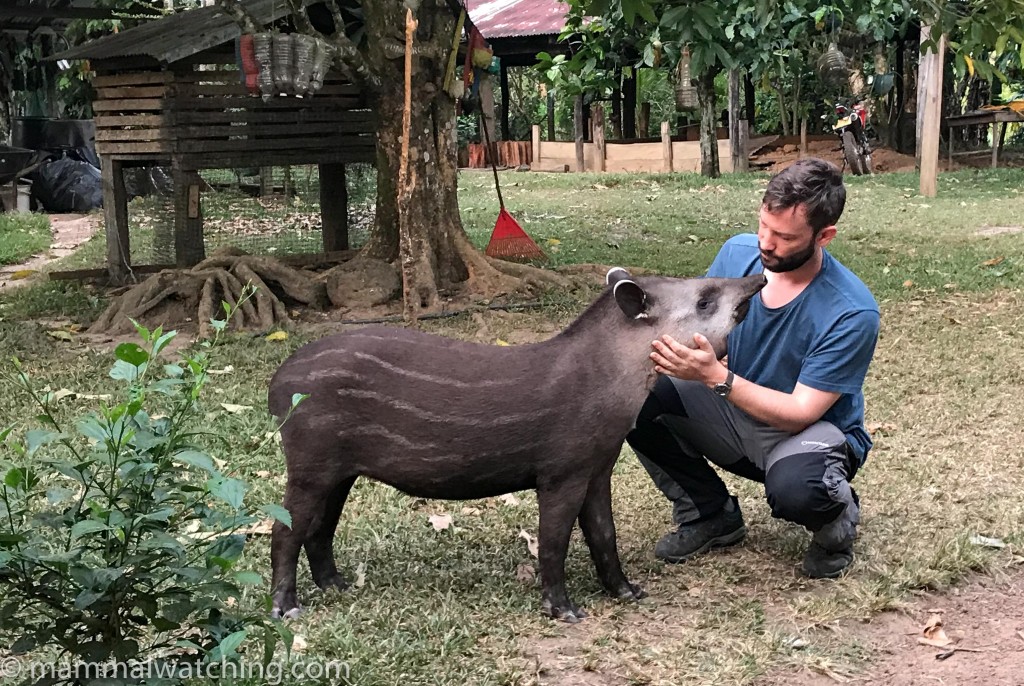
Hercules and Rob
January 15. We were on an afternoon flight out of Guaviare to Bogota and spent the morning taking a boat trip along the Guayabero River at Remolino Los Dorados. There was a small chance for White-fronted Spider Monkeys here (Rob has a much more reliable spot for that species near Villavicencio) and a better chance for Botos. The Guayabero is a tributary of the Orinocco, rather than the Amazon, and there is a vague rumour that the Amazonian and Orinocan species might be split one day. The animals here were much greyer than the pink river dolphins I have seen elsewhere.
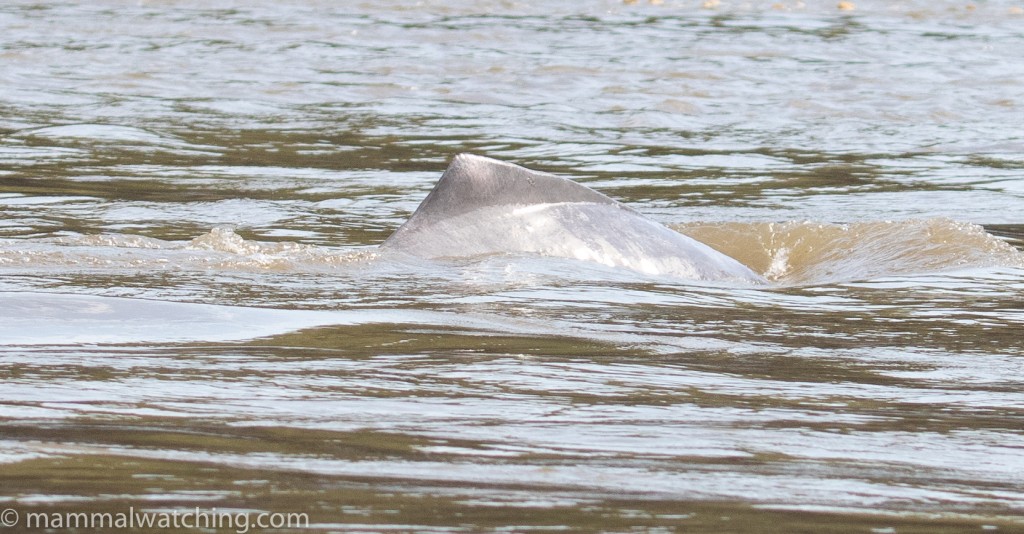
Orinoco River Dolphin (Boto), Inia geoffrensis humboldtiana
Early morning is the best time to see the dolphins we were told and we saw animals two minutes after leaving the dock, and we had fabulous views of several other dolphins that were hanging around their usual spot 20 minutes upriver.
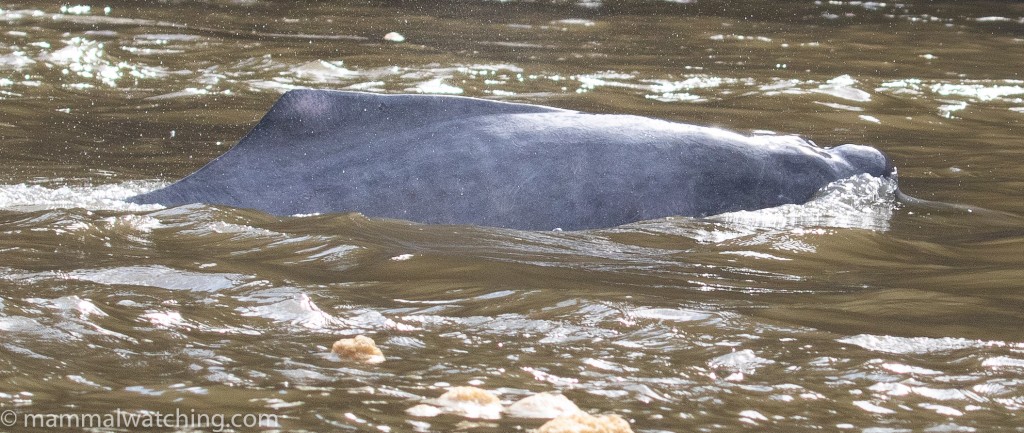
Orinoco River Dolphin (Boto), Inia geoffrensis humboldtiana
And then it was back to Guaviare for the short flight to Bogota and a really excellent dinner in a downtown restaurant with Cheryl, Rob and Claudia before my flight home.
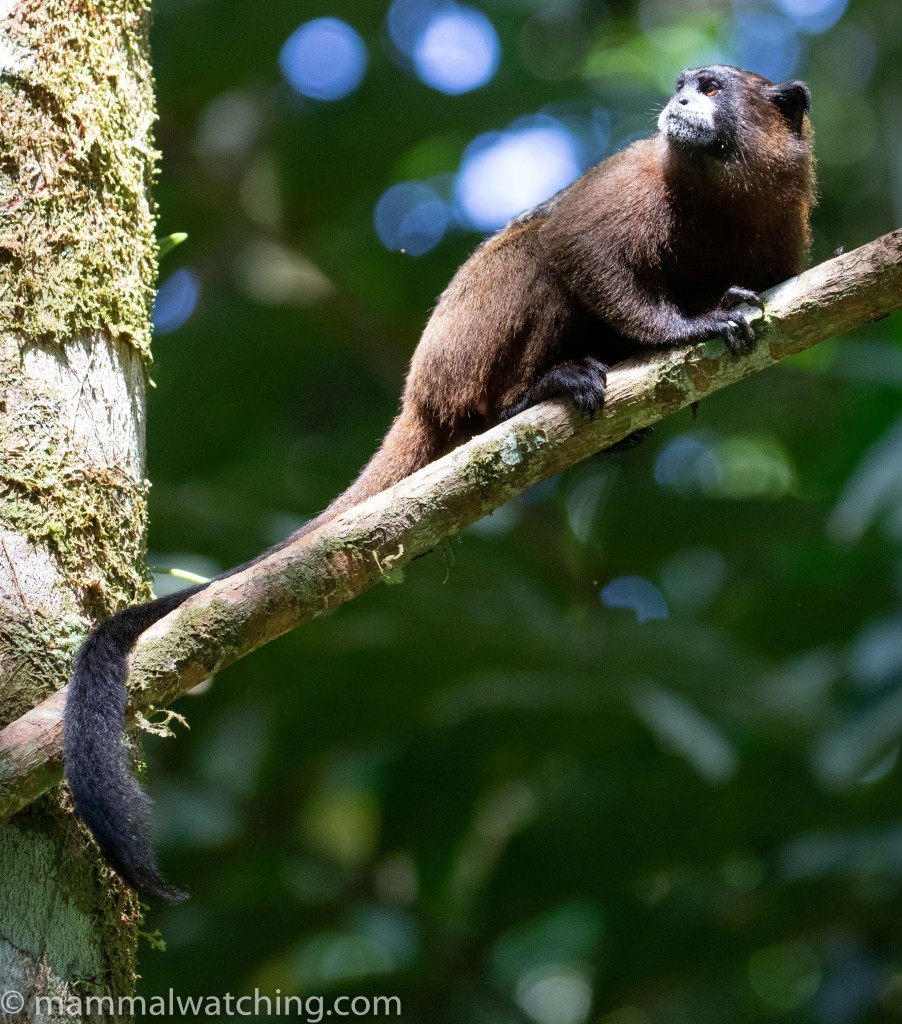
Lesson’s Saddle-backed Tamarin, Leontocebus fuscus
Stuff We Missed
Not very much is the short answer. Before I arrived in Colombia I hoped we might see about 30 species and that I could pick up 10 lifers. We almost doubled both numbers.
Of course there are many more species in Colombia than the 50 we saw but we weren’t targeting them. For instance Rob has very good sites for Spectacled Bear and Mountain Tapir. I am already thinking of a return and Rob is working on finding sites for a long wishlist of species from the group. Pacarana is my top pick. And Margay. And a few more primates. But there are plenty more. This is a country to return to again and again.
Thank You
A massive thanks to Rob and Claudia for organizing such a successful trip to perfection as well as to all the local guides and the landowners who are helping protect Colombia’s wildlife and who welcomed us with open arms. And of course a big thank you to the whole group for being such energetic and good – never complaining – company and spotting so much. And finally thank you to Colombia for being, well, for being Colombia, I love this place, the people, the wildlife. the arepas and the beer.
Trip List
Armadillo sp.*
Robinson’s Mouse-Opossum Marmosa robinsoni
Southern Opossum Didelphis marsupialis
Brown-eared (Western) Woolly Opossum Caluromys lanatus
Giant Anteater Myrmecophaga tridactyla
Brown-throated Three-toed Sloth Bradypus variegatus
Santander Dwarf Squirrel Microsciurus santanderensis
Bicolored Arboreal Rice Rat Oecomys bicolor
Amazonian Long-tailed Porcupine Coendou longicaudatus
Black Agouti Dasyprocta fuliginosa
Red-tailed Squirrel Sciurus granatensis*
Mouse sp.*
Boyacá Spiny Rat Proechimys chrysaeolus*
O’Connell’s Spiny Rat Proechimys oconnelli
Arboreal Soft-furred Spiny Rat Diplomys caniceps
Crab-eating Fox Cerdocyon thous
Allen’s Olingo Bassaricyon alleni
Crab-eating Raccoon Procyon cancrivorus
Greater White-lined Bat Saccopteryx bilineata
Lesser White-lined Bat Saccopteryx leptura
Greater Dog-like Bat Peropteryx kappleri
Lesser Dog-like Bat Peropteryx macrotis
Lesser Spear-nosed Bat Phyllostomus elongatus
Miller’s Long-tongued Bat Glossophaga longirostris
Silky Short-tailed Bat Carollia brevicauda
Seba’s Short-tailed Bat Carollia perspicillata
Jamaican Fruit-eating Bat Artibeus jamaicensis
Great Fruit-eating Bat Artibeus lituratus
Striped Hairy-nosed Bat Gardnerycteris crenulatum
Common Vampire Bat Desmodus rotundus
Riparian Myotis Myotis riparius
Lesson’s Saddle-backed Tamarin Leontocebus fuscus
Mottle-faced Tamarin Saguinus inustus
Silvery-brown Bare-faced Tamarin Saguinus leucopus
Pygmy Marmoset Cebuella pygmaea
Colombian Squirrel Monkey Saimiri albigena
Ecuadorean Squirrel Monkey Saimiri macrdon
Common Squirrel Monkey Saimiri sciureus
Varied Capuchin Cebus versicolor
Guianan Brown (Large-headed) Capuchin Sapajus apella
Grey-handed Night Monkey Aotus griseimembra
Brumback’s Night Monkey Aotus brumbacki
Noisy Night Monkey Aotus vociferans
Caqueta Titi Callicebus caquetensis
Lucifer Titi Callicebus lucifer
Collared (Black) Titi Callicebus lugens
Medem’s Titi Callicebus medemi
Ornate Titi Callicebus ornatus
Golden-backed (Black) Uakari Cacajao melanocephalus
Brown Spider Monkey Ateles hybridus
Brown Woolly Monkey Lagothrix lagotricha
Colombian Woolly Monkey Lagothrix lagotricha lugens
Colombian Red Howler Monkey Alouatta seniculus
Orinoco River Dolphin (Boto) Inia geoffrensis humboldtiana
53 species with 19 lifers (bold). Some of the small mammals were identified by range and on the balance of probability so please let me know if we have overlooked anything.
I didn’t see the species marked with a *.
2 Comments
-
Jon Hall
I am sorry Angel but I don’t know the name. You should contact Wild About Colombia – https://www.mammalwatching.com/listing/wild-about-colombia/
Jon
Leave a Reply
You must be logged in to post a comment.


Ángel
Hello, thank you very much for the trip report, it has helped me a lot in planning my trip to Colombia. In a few months I will travel to Villavicencio and I would like to ask you if you remember the name of the Finca (farm) where you were seeing Giant Anteaters, Ornate Titis and Brumback’s Night Monkeys. Thank you very much.